[BM] 05.3
DEAR READER, PLEASE READ: SHALL WE READ FURTHER?
POSTED ON 19.09.2020
IN CONVERSATION—
FURTHER READING (JANUAR RIANTO)
WATERPROOF EXHIBITIONS (RAWIRUJ SURADIN / NAPISA LEELASUPHAPONG)
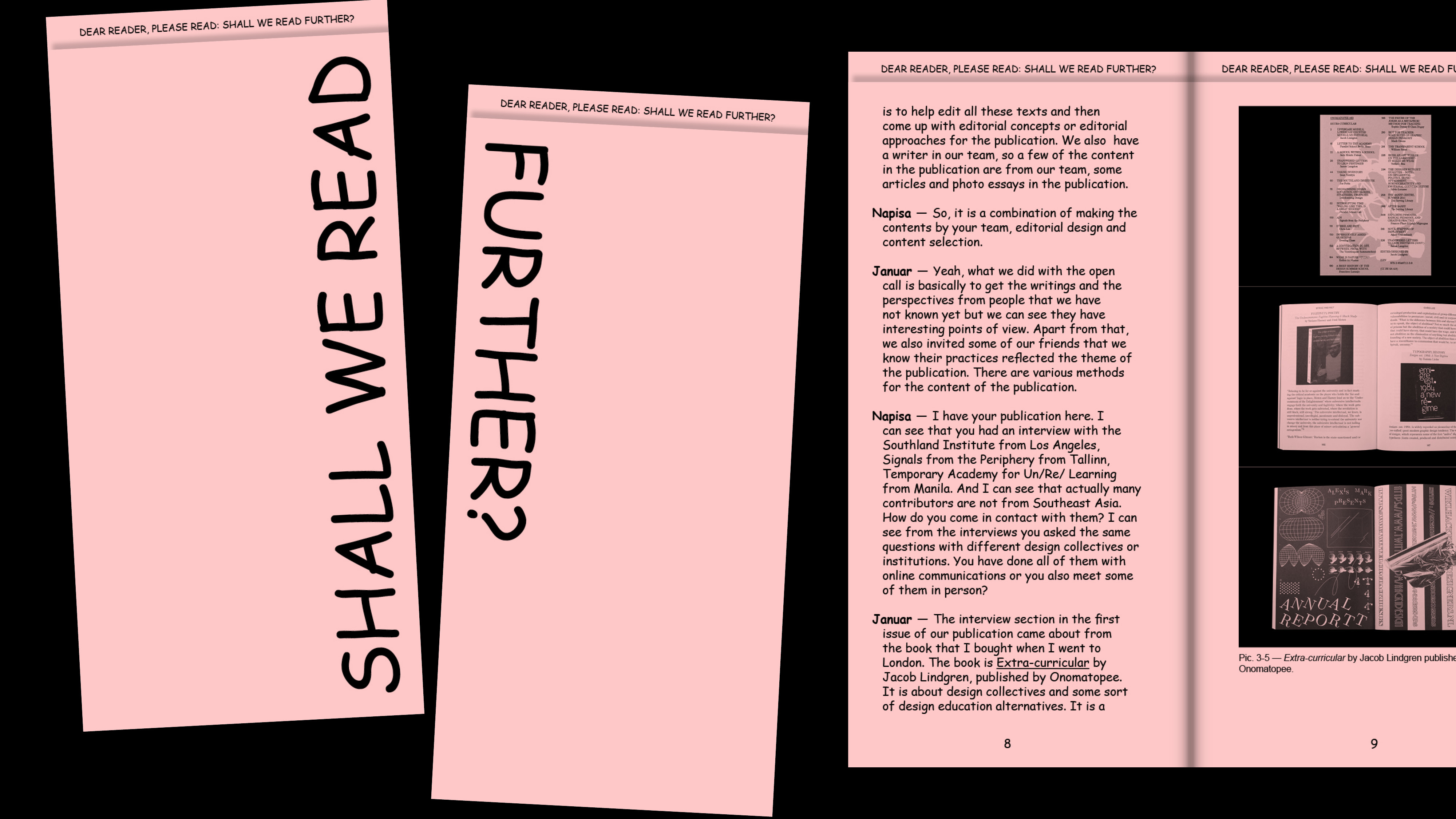
What should a graphic designer read to work on? “I think it is also important to keep promoting reading. Reading as a habit…” and “It is important for the designer to read” are some of the points that Januar Rianto believes in.
Further Reading is a publishing platform from Indonesia, co-founded by Januar Rianto to share texts and publications which reflect his interest in design discipline. It started casually from the sharing of reading references in his design studio and evolved into a platform that aims to reach broader audiences.
For this CO-OP dialogue, Waterproof Exhibitions, a Thai art initiative, invited Further Reading for this conversation about the starting point of their platform. Why is a designer interested in the role of editor for a publication platform? What are the subjects that they are interested in or find useful for the design discipline? What is the problem with design education in Southeast Asian countries? The conversation also involved questions on the text and content that is needed from a local author, the difference between online and printed publication, to their reading references that may interest some readers.
นักออกแบบอ่านอะไรเพื่อที่จะทำงานต่อไปได้ เป็นคำถามที่น่าสนใจสำหรับนักออกแบบทั้งในระดับท้องถิ่นและสากล “การอ่านจำเป็นสำหรับนักออกแบบ” และ “เราต้องการให้การอ่านเป็นนิสัยของนักออกแบบ” คือสิ่งที่จานัวร์ ริยันโต ผู้ร่วมก่อตั้ง Further Reading เชื่อมั่น แพลตฟอร์มเผยแพร่เนื้อหาจากอินโดนีเซียภายใต้ชื่อ Further Reading นี้ก่อตั้งขึ้นเพื่อแบ่งปันตัวบทหรือสิ่งพิมพ์ที่มีความสนใจหลักเกี่ยวกับการออกแบบ เขาเริ่มต้นอย่างง่ายๆ จากการแชร์ความรู้ระหว่างกันในสตูดิโอออกแบบของเขาเอง จนกลายมาเป็นแพลตฟอร์มที่มีเป้าหมายเพื่อเข้าถึงนักอ่านจากทั่วโลก
บทสนทนาระหว่างสมาชิก BKKABF CO-OP ในครั้งนี้ Waterproof Exhibitions กลุ่มศิลปินจากประเทศไทย ได้ชวน Further Reading พูดคุยถึงที่มาที่ไปในการเกิดขึ้นของแพลตฟอร์ม อะไรทำให้นักออกแบบสนใจบทบาทของบรรณาธิการหรือผู้คัดเลือกเนื้อหาเพื่อเผยแพร่ลงบนแพลตฟอร์มการเผยแพร่เนื้อหา ประเภทของเนื้อหาแบบไหนที่พวกเขาสนใจและเห็นว่าเป็นประโยชน์ ปัญหาของการเรียนการสอนการออกแบบในเอเชียตะวันออกเฉียงใต้ที่ขาดการส่งเสริมการอ่าน และต้นฉบับของตัวบทแบบไหนที่เป็นที่ต้องการในระดับท้องถิ่นและมาจากนักเขียนท้องถิ่น ความแตกต่างในการเผยแพร่แบบออนไลน์และเผยแพร่ผ่านสิ่งพิมพ์ และร่วมแชร์สิ่งพิมพ์ที่ทั้งสองกลุ่มคิดว่าน่าสนใจจะส่งต่อสู่นักอ่าน
Rawiruj Suradin (Rawiruj) — Could you please introduce yourself? What did you do before founding Further Reading?
Januar Rianto (Januar) — My name is Januar Rianto, a graphic designer. I run Each Other Company, a graphic design studio. We mainly work for cultural and creative clients, but also commercial clients like hospitality or F&B. Apart from Each Other Company, I also run Further Reading, a publication platform mainly focused on design subjects. Further Reading started two years after we started the studio. We have started the studio in 2015 and Further Reading in 2017. Through Further Reading we do exhibitions, publish printed publications, do curations and programmes both online and offline. We are based in Jakarta, but our contributors are from different places in the world.
รวิรุจ สุรดินทร์ (รวิรุจ) — อยากให้แนะนำตัวและเล่าให้ฟังหน่อยว่าคุณทำอะไร และก่อนที่จะเกิด Further Reading คุณทำอะไรอยู่ก่อนหน้านี้?
จานัวร์ ริยันโต (จานัวร์) — เราชื่อจานัวร์ ริยันโต เป็นกราฟิกดีไซเนอร์ และทำบริษัทออกแบบกราฟิกชื่อ Each Other Company ซึ่งทำงานกับลูกค้าในแวดวงวัฒนธรรมและวงการสร้างสรรค์เป็นส่วนใหญ่ แต่ก็ยังมีลูกค้าเชิงพาณิชย์ อย่างธุรกิจบริการ ธุรกิจอาหารด้วย นอกจาก Each Other Company เรายังทำ Further Reading แพลตฟอร์มเผยแพร่เนื้อหาที่มีความสนใจหลักเกี่ยวกับการออกแบบ Further Reading เกิดขึ้นในปี 2560 สองปีหลังจากเราเริ่มทำ Each Other Company ในปี 2558 สำหรับ Further Reading เราทำนิทรรศการ ตีพิมพ์สิ่งพิมพ์ คิวเรทผลงาน และทำโครงการต่างๆ ทั้งในรูปแบบออนไลน์และออฟไลน์ เราทำงานที่เมืองจาการ์ตา แต่คนที่ร่วมงานกับเรามาจากที่ต่างๆ ทั่วโลก
Rawiruj — Are there any members in Further Reading that come from the studio? How many people when you have started this? And can you tell us more about your initial involvement in graphic design?
Januar — I started Further Reading with our team in the studio. We basically share the same interests. At first, we act like the editor of the project. So, we basically share our interests and our reading references together, then we discuss which one to publish, which one to share. So, from the start the team of Further Reading is pretty much the same as our studio team. We had three people when we started. It was me, one designer, and one intern, and we basically talked during lunch. There is the problem of design education in Indonesia. Because it is not much of a critical discourse within the educational system. It is not much of a discussion going on even within the institutions, within the schools or anything. We think that we have to fill in the gap by providing an alternative, so we decided to start Further Reading.
Actually I have never studied graphic design in Indonesia. I took my diploma in graphic design in Kuala Lumpur and then transferred to graphic design in London. But my designers are mostly from Indonesia, they are quite familiar with the education situation here.
รวิรุจ — สมาชิกที่อยู่ใน Further Reading มาจากสตูดิโอด้วยรึเปล่า? คนที่เกี่ยวข้องในตอนเริ่มต้นมีกี่คน? อยากให้ช่วยเล่าเกี่ยวกับจุดเริ่มต้นในการเข้ามาเกี่ยวข้องกับการออกแบบกราฟิก
จานัวร์ — เราเริ่ม Further Reading ร่วมกับทีมในสตูดิโอ เพราะพวกเรามีความสนใจที่ตรงกัน ในช่วงเริ่มต้นพวกเราทำหน้าที่เป็นเหมือนบรรณาธิการของโปรเจกต์ เรามีเรื่องที่สนใจร่วมกันและแชร์แหล่งข้อมูลของสิ่งที่เราอ่านกัน จากนั้นเราเริ่มมาคุยกันว่าสิ่งไหนควรถูกแชร์ หรือถูกเผยแพร่ออกไป ในตอนเริ่มต้นทีมของ Further Reading คือทีมเดียวกันกับทีมของสตูดิโอ เราเริ่มต้นกันสามคนคือ ตัวเรา ดีไซน์เนอร์อีกคน และอินเทิร์น คุยกันในช่วงเวลาอาหารกลางวัน มันมีปัญหาเกี่ยวกับการศึกษาเรื่องการออกแบบในอินโดนีเซีย ปัญหาคือเราไม่มีการพูดคุย ถกเถียงในเชิงวิพากษ์เท่าไหร่ในวงการการศึกษา ทั้งในโรงเรียน หรือสถาบันต่างๆ พวกเรารู้สึกว่าเราต้องเติมเต็มช่องว่างนี้โดยการเพิ่มทางเลือกให้กับผู้ที่สนใจ นั่นคือจุดที่ทำให้เราตัดสินใจทำ Further Reading
ความจริงแล้วเราไม่เคยเรียนกราฟิกดีไซน์ในอินโดนีเซีย เราเรียนกราฟิกดีไซน์ในกัวลาลัมเปอร์ และย้ายไปเรียนที่ลอนดอน แต่นักออกแบบของเราส่วนใหญ่มาจากอินโดนีเซีย และพวกเขาก็ค่อนข้างคุ้นเคยกับสถานการณ์ด้านการศึกษาที่นี่ดี
Rawiruj — We can see that for your studio and Further Reading, you have a very different goal for them. What are their starting points? And why do you become interested in texts, stories and research?
Januar — I think the starting point was when I found the studio in 2015. Before I started Each Other Company I was working in the small graphic design studio where it mostly deals with art, like art catalogues or art exhibition identity. Because it was my first official job when I returned to Indonesia, so at the time I was not really exposed to the industry as a whole. So, for my own studio I would like to explore graphic design as a discipline, graphic design like my time back in the university in Kuala Lumpur and London. The studio started with two main focuses, fifty percent we want to focus on client projects. And because of the size of the studio we have to come up with a side project. So it is to balance out between the commercial and the idealism side of the studio, to see it as an important practice for us to not just do commercial works but also keep exploring, keep developing our criticality, our design thinking. We produce various side projects, and one of them is Further Reading. It is one of the most recognizable projects, so we try to grow it, to make it more serious. Now we treat it as a new entity.
รวิรุจ — เราเห็นได้ชัดว่าคุณมีเป้าหมายที่แตกต่างกันอย่างชัดเจนระหว่างสตูดิโอและ Further Reading จุดเริ่มต้นเหล่านั้นคืออะไรและทำไมคุณถึงหันมาสนใจในตัวบท เรื่องราว และงานวิจัย?
จานัวร์ — เราคิดว่าจุดเริ่มต้นมาจากการเริ่มทำ Each Other Company ในปี 2558 ก่อนที่จะเริ่มทำสตูดิโอนี้ เราทำงานในสตูดิโอกราฟิกเล็กๆ แห่งหนึ่งซึ่งงานส่วนใหญ่เกี่ยวข้องกับศิลปะ อย่างการทำแคตตาล็อกศิลปะ หรือการผลิตอัตลักษณ์ให้กับนิทรรศการศิลปะ แต่เพราะนั่นเป็นงานแรกที่เราทำหลังจากกลับมาอินโดนีเซีย เวลานั้นเราเลยยังไม่ได้รู้จักวงการมากนัก พอได้มาทำสตูดิโอของตัวเองเราก็เลยอยากสำรวจความเป็นไปได้ในการทำงานกราฟิกดีไซน์ในเชิงวิธีการทางกราฟิกดีไซน์เหมือนตอนที่ได้ทดลองในมหาวิทยาลัยที่กัวลาลัมเปอร์และลอนดอน สตูดิโอมีความสนใจหลักสองอย่าง ครึ่งหนึ่งเราโฟกัสกับงานของลูกค้า และด้วยขนาดของสตูดิโอเราอยากมีการทำโปรเจกต์เสริมด้วย มันเลยกลายเป็นการหาสมดุลระหว่างงานด้านพาณิชย์ และแง่มุมเชิงอุดมคติของสตูดิโอ เพื่อมองหาความสำคัญของการทำงานที่ไม่ใช่แค่โปรเจกต์เชิงพาณิชย์ แต่ยังคงทำการสำรวจ พัฒนาวิธีคิดเชิงวิพากษ์ และวิธีคิดทางการออกแบบ ควบคู่กันไป เราทำโปรเจกต์เสริมหลายอย่าง หนึ่งในนั้นคือ Further Reading และมันกลายเป็นหนึ่งในโปรเจกต์ที่ได้รับการพูดถึงมากที่สุด เราเลยอยากจะพัฒนาและจริงจังกับมันมากขึ้น ตอนนี้เรามองมันเป็นเหมือนกับพื้นที่ใหม่
Napisa Leelasuphapong (Napisa) — I would like to go back a little bit. You said that you share references between your colleagues. Where do those references come from? Having an educational background in design, we see the problem in design education here in Thailand too, the problem that we may lack the references, especially good resources for those references, like a place for books, magazines, and researches on design.
Januar — We were lucky because when we started Further Reading all of us like stories. Basically we have a lot of bookmarks on our web browsers, and we started from there, curated our own references, and discussed which one to publish. The name Further Reading is part of the textual references. It was a quick reference, we want it to be short but also substantial. At first most of our references came from other publications, other books and magazines, or references that are already available on the internet. Because we think that there are a lot of references that are not really well exposed to the readers. I think it is important to bring literature to the surface so people can have access to the reading. That is what we do for the online platform. We slowly do more segments, we do the projects like Bookmark, Bookshelf etc. Then we start to invite our friends to share their own reading references.
Pic.1 — Bookshelf project by Further Reading posted on an instagram. In this image are the books recommended by Alice Rawsthorn including Radical Technologies: The Design of Everyday Life by Adam Greenfield, Invisible Women by Caroline Criado-Perez, Radical Help by Hilary Cottam, AK47: The Story of the People’s Gun by Michael Hodges, Irma Boom: The Architecture of the Book by Irma Boom.
In 2018 we came up with our own contents by doing a printed publication called Further Reading Print No.1. The starting point was that during my trip to London last year I rarely saw design books or design magazines from Southeast Asia, so from that trip me and my team thought it would be a good idea to have a space for people from the region, people from Asia to bring out their voices. 
Pic.2 — Further Reading Print No.1, the first printed publication by Further Reading.
นภิษา ลีละศุภพงษ์ (นภิษา) — ขอย้อนกลับไปที่คุณบอกว่าคุณแชร์แหล่งข้อมูลหนังสือหรือบทความระหว่างกันในสตูดิโอ แหล่งข้อมูลพวกนั้นมาจากไหน? ด้วยความที่เราก็เรียนเกี่ยวกับการออกแบบมาเหมือนกัน เราเห็นปัญหานี้เช่นกันในประเทศไทย ซึ่งอาจเกิดจากการที่เราขาดแหล่งข้อมูลอ้างอิง โดยเฉพาะแหล่งทรัพยากรและการเข้าถึงสำหรับข้อมูลพวกนั้น อย่างสถานที่ที่มีหนังสือ นิตยสาร หรืองานวิจัยที่เกี่ยวข้องกับกราฟิกดีไซน์
จานัวร์ — พวกเราโชคดีที่ Further Reading เริ่มต้นจากความสนใจในเรื่องราวเหมือนกัน ทำให้เรามีบุ๊คมาร์คในเว็บเบราเซอร์เยอะมาก เราเลยเริ่มจากตรงนั้น คัดเลือกแหล่งอ้างอิงของพวกเรา และคุยกันว่าอันไหนที่ควรจะเผยแพร่ออกไป ชื่อ Further Reading เองก็เป็นส่วนหนึ่งของการพูดถึงการอ้างอิงตัวบท แหล่งอ้างอิงพวกนี้ถูกรวบรวมขึ้นแบบเร็วๆ เราอยากให้มันสั้นแต่ได้ใจความ จุดเริ่มต้นแหล่งอ้างอิงเหล่านั้นมาจากสิ่งพิมพ์อื่นๆ หนังสือ หรือนิตยสารซึ่งมีอยู่ในอินเทอร์เน็ต เพราะพวกเรารู้สึกว่ามีแหล่งอ้างอิงจำนวนมากที่ไม่ได้ถูกเผยแพร่ให้ผู้อ่านได้เห็นทั่วไป เราคิดว่ามันสำคัญที่งานเขียนควรถูกทำให้พบเห็นได้ง่ายขึ้นสำหรับผู้อ่าน ซึ่งเป็นสิ่งที่เราทำสำหรับแพลตฟอร์มออนไลน์ เราค่อยๆ เพิ่มส่วนอื่นๆ เข้าไป อย่าง Bookmark Bookshelf และอื่นๆ จากนั้นเราก็ชวนเพื่อนที่รู้จักเข้ามาแชร์แหล่งข้อมูลที่พวกเขามี
รูป 1 — โปรเจกต์ Bookshelf โดย Further Reading โพสต์บนอินสตาแกรม ในภาพคือหนังสือที่แนะนำโดย อลิส รอวสตอน ได้แก่ Radical Technologies: The Design of Everyday Life โดย อดัม กรีนฟีลด์ Invisible Women โดย คาโรลีน ครีอาโด เปเร่ Radical Help โดย ฮิรารี คอทแทม AK47: The Story of the People’s Gun โดย มิคาเอล ฮอด์จ Irma Boom: The Architecture of the Book โดย เออร์มา บูม
ปี 2561 เราเริ่มสร้างเนื้อหาขึ้นเองผ่านการทำสิ่งพิมพ์ Further Reading Print No.1 ซึ่งเริ่มมาจากทริปที่ลอนดอนเมื่อปีที่แล้วที่เราแทบไม่เห็นหนังสือหรือนิตยสารที่มาจากเอเชียตะวันออกเฉียงใต้เลย จากทริปนั้นทำให้พวกเราคิดว่าน่าจะดีถ้าเราสร้างพื้นที่ให้กับผู้คนในภูมิภาค ผู้คนในเอเชีย ให้สามารถแสดงตัวตนพวกเราออกไปได้
รูป 2 — Further Reading Print No.1 สิ่งพิมพ์เล่มแรกโดย Further Reading
Napisa — That should be the reason you did the open call for the publication. What about your role in this Further Reading Print No.1 publication project?
Januar — I was more in design and creative directing in the past, and I also did some curations. So, I think what I can do best is to help edit all these texts and then come up with editorial concepts or editorial approaches for the publication. We also have in our team a writer, so a few of the content in the publication are from our team, some articles and photo essays in the publication.
นภิษา — เหตุผลในการเปิดโอเพ่นคอล (open call) ให้กับหนังสือเล่มนี้คงมาจากตรงนั้น ในส่วนของบทบาทคุณในโปรเจกต์สิ่งพิมพ์ Further Reading Print No.1 นี้มีอะไรบ้าง?
จานัวร์ — เรามีประสบการณ์ในการออกแบบ กำหนดทิศทางของงานสร้างสรรค์ และเคยคิวเรทผลงานมาก่อน เราคิดว่าบทบาทที่เราทำได้ดีที่สุดในตอนนี้คือช่วยเรียบเรียงเนื้อหา และวางคอนเซปต์ของงานบรรณาธิการสำหรับสิ่งพิมพ์เล่มนี้ ในทีมเรามีนักเขียนอยู่ด้วย ดังนั้นเนื้อหาบางส่วนของเล่มนี้ก็มาจากทีมของเราเอง อย่างพวกบทความและภาพเล่าเรื่อง (photo essay)
Napisa — So, it is a combination of making the contents by your team, editorial design and content selection.
Januar — Yeah, what we did with the open call is basically to get the writings and the perspectives from people that we have not known yet but we can see they have interesting points of view. Apart from that, we also invited some of our friends that we know their practices reflected the theme of the publication. There are various methods for the content of the publication.
นภิษา — ในเล่มเลยเป็นการผสมระหว่างเนื้อหาที่มาจากทีมคุณเอง การออกแบบงานบรรณาธิการ และการคัดเลือกเนื้อหา
จานัวร์ — ใช่ การที่เราเลือกเปิดรับเนื้อหาแบบโอเพ่นคอล เป็นเพราะเราต้องการได้งานเขียนที่มีมุมมองจากผู้คนที่เราอาจไม่รู้จักมากนัก แต่ทำให้เราได้เห็นถึงมุมมองที่น่าสนใจ นอกจากนั้นเรายังชวนเพื่อนๆ ที่เรารู้ว่างานของพวกเขาสะท้อนถึงสาระสำคัญของโปรเจกต์ เราใช้วิธีการหลากหลายในการได้มาซึ่งเนื้อหาของสิ่งพิมพ์เล่มนี้
Napisa — I have your publication here. I can see that you had an interview with the Southland Institute from Los Angeles, Signals from the Periphery from Tallinn, Temporary Academy for Un/Re/ Learning from Manila. And I can see that actually many contributors are not from Southeast Asia. How do you come in contact with them? I can see from the interviews you asked the same questions with different design collectives or institutions. You have done all of them with online communications or you also meet some of them in person?
Januar — The interview section in the first issue of our publication came about from the book that I bought when I went to London. The book is Extra-curricular by Jacob Lindgren, published by Onomatopee. It is about design collectives and some sort of design education alternatives. It is a compilation of interviews on and around the topic of self-organised learning, curriculum, experiments and alternatives in graphic design education.
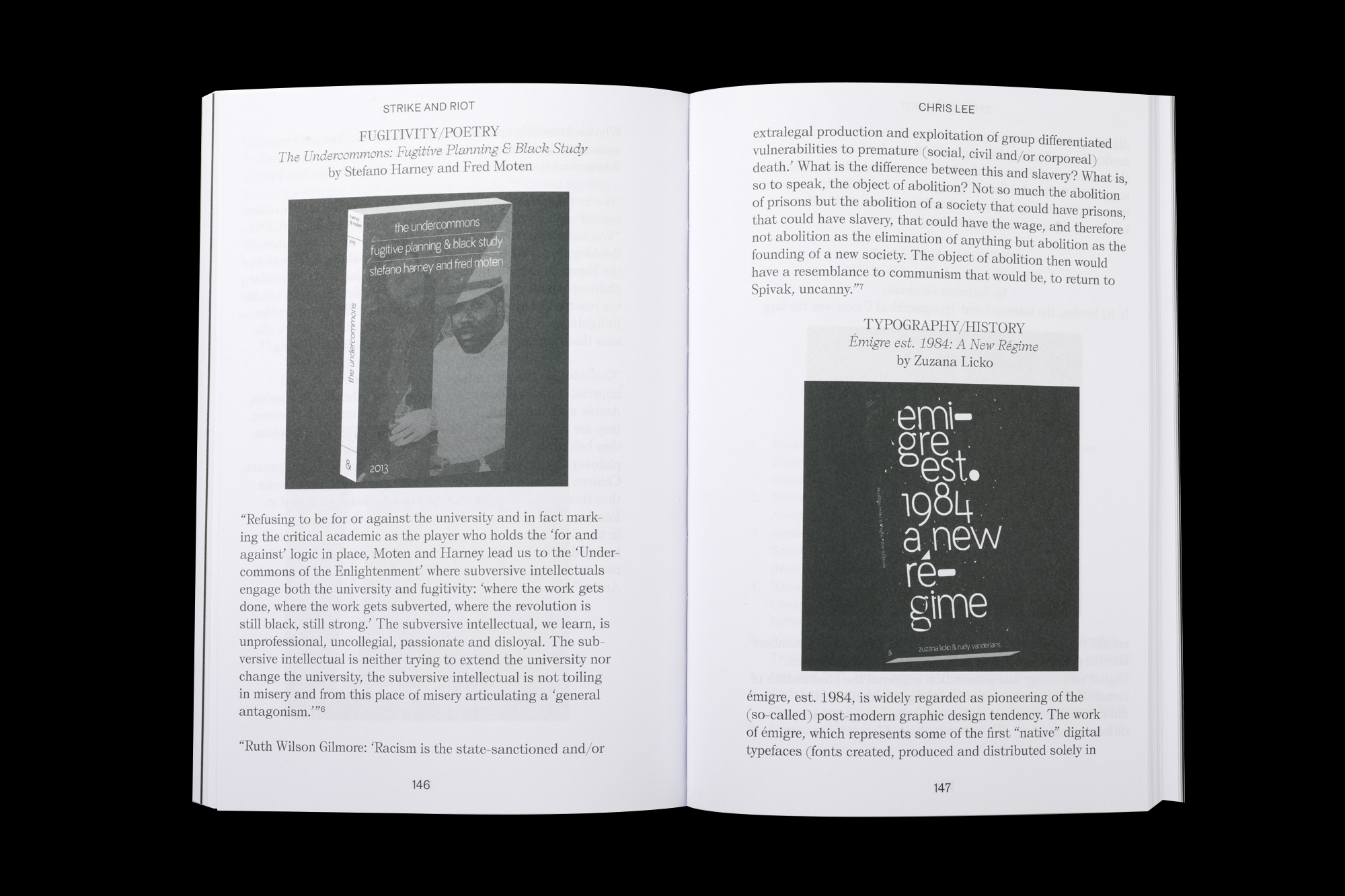
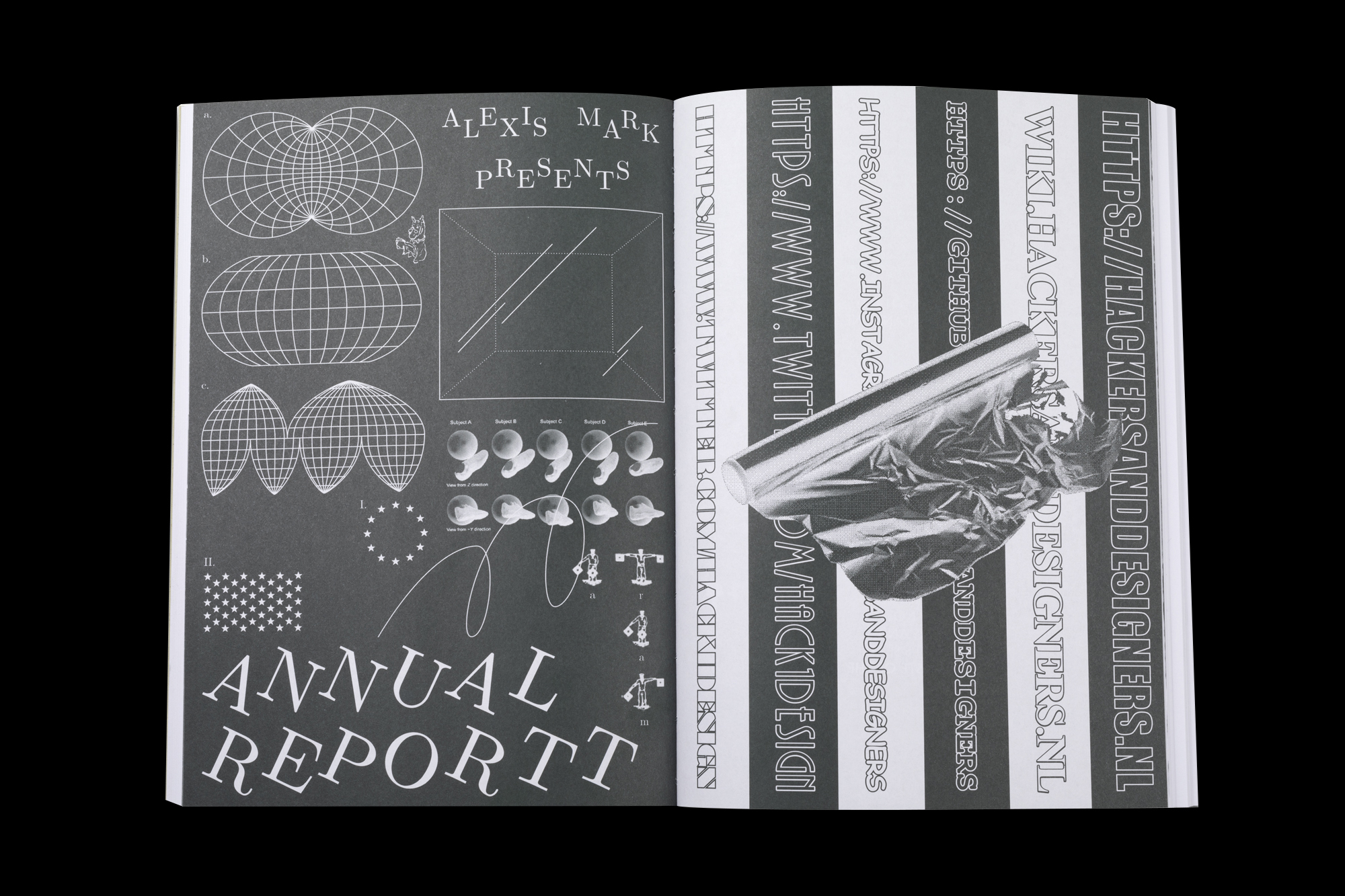
Pic. 3-5 — Extra-curricular by Jacob Lindgren published by Onomatopee.
We think that the subject is suitable for our first issue so we basically sent them an email introducing ourselves who we are, what is Further Reading and what we are trying to do with it. We also explained what the theme of the publication is about and then started from there. It started from the email and then we asked if there were available for an interview.
We basically want to use the same question for the interview and try to get the perspectives from Europe, Southeast Asia and the US. And then you can see, maybe, the differences or similarities between practices from different places.
The interviews happened through emails. We asked the questions mainly with email and sometimes it was going back and forth if we needed some clarifications. It was less interactive but still interactive.
นภิษา — เรามีหนังสือเล่มนี้อยู่กับเราตรงนี้ เห็นว่ามีการสัมภาษณ์ Southland Institute จากลอสแอนเจลิส Signals from the Periphery จากเมืองทาลลินน์ Temporary Academy for Un/Re/ Learning จากมะนิลา และเรายังเห็นว่ามีผู้เข้าร่วมอีกหลายคนที่ไม่ได้มาจากเอเชียตะวันออกเฉียงใต้ คุณติดต่อพวกเขาเหล่านี้ด้วยวิธีการอะไร? เรายังเห็นว่าคุณใช้คำถามสำหรับการสัมภาษณ์ชุดเดียวกันกับทุกคน คุณสื่อสารออนไลน์กับทุกคนหรือมีการสัมภาษณ์แบบเจอตัวกันด้วย?
จานัวร์ — แนวคิดในส่วนของบทสัมภาษณ์ในเล่มแรกนี้มาจากหนังสือเล่มหนึ่งที่เราซื้อมาเมื่อตอนไปลอนดอน ชื่อว่า Extra-curricular โดย ยอคอบ ลินด์เกรน ตีพิมพ์โดยสำนักพิมพ์ Onomatopee เกี่ยวกับกลุ่มนักออกแบบ และกลุ่มการศึกษาที่เกี่ยวข้องกับการออกแบบ ในลักษณะทางเลือก มันประกอบด้วยบทสัมภาษณ์ทั้งโดยตรงและรอบๆ เรื่องการจัดการการเรียนรู้ด้วยตนเอง หลักสูตร การทดลอง และการศึกษากราฟิกดีไซน์แบบทางเลือก


รูป 3-5 — Extra-curricular โดย ยอคอบ ลินด์เกรน ตีพิมพ์โดยสำนักพิมพ์ Onomatopee
พวกเรารู้สึกว่าหัวข้อนี้เข้ากันได้กับหนังสือเล่มแรกที่พวกเราจะทำ เราเลยส่งอีเมลไปแนะนำตัวกับกลุ่มที่เราสนใจว่า Further Reading คือใคร และพวกเรากำลังทำอะไร รวมถึงอธิบายว่าสาระสำคัญของหนังสือเกี่ยวข้องกับอะไร เราเริ่มจากอีเมลตรงนั้นและคุยกับคนที่เราต้องการสัมภาษณ์ว่าสะดวกให้พวกเราสัมภาษณ์รึเปล่า
เราต้องการใช้คำถามที่เหมือนกันเพื่อดูมุมมองต่างๆ ทั้งจากยุโรป เอเชียตะวันออกเฉียงใต้ และสหรัฐอเมริกา จากบทสัมภาษณ์เราอาจได้เห็นสิ่งที่เหมือนหรือแตกต่างกันระหว่างกลุ่มต่างๆ ในพื้นที่ต่างๆ
บทสัมภาษณ์เกิดขึ้นผ่านอีเมลและมีการถามตอบไปมาหากเราต้องการคำอธิบายบางอย่าง มันอาจจะไม่เกิดการโต้ตอบโดยทันที แต่ก็ยังมีการปฏิสัมพันธ์กันอยู่ในนั้น
Rawiruj — How do you decide which content should go online and which content should be published in a physical form?
Januar — That was our discussions in the first place. Because we started the online first and it was mainly a reposting from other people’s writings, we only curated and republished, and then printed publication came about because a lot of our friends and our readers asked about original contents like some new writings, some new works. So we discussed the idea internally and decided to differentiate the content between the online and the publication. The way we differentiate, I think, was mostly based on the medium we are working on. For the online, it has to be quicker, faster content. What we do online is basically very loose, very casual, we do not have a specific theme. It could be any subject. And for the print, we have more time to select which one is more suitable, we want to focus on one specific theme and really dig deep into the subject. I think this is the main difference, the print may have more in-depth perspectives, in-depth analysis. People could read the print and have different experiences than the online and also different experiences from our other projects like our curations and exhibitions.
รวิรุจ — คุณเลือกยังไงว่าเนื้อหาอันไหนควรจะถูกลงในแพลตฟอร์มออนไลน์และอันไหนควรตีพิมพ์ลงในหนังสือ?
จานัวร์ — เรื่องนี้เป็นสิ่งที่เราถกเถียงกันตั้งแต่แรก จากการที่เราเริ่มต้นจากออนไลน์ ด้วยวิธีการรีโพสต์เนื้อหาจากงานเขียนของคนอื่น เราทำหน้าที่คัดเลือก และตีพิมพ์ซ้ำ หลังจากนั้นเรามาทำสิ่งพิมพ์เพราะเพื่อนและผู้อ่านหลายคนของเราถามหาถึงเนื้อหาต้นฉบับ งานเขียนใหม่ๆ และผลงานใหม่ๆ พวกเราคุยเรื่องนี้กันภายในทีมและคิดว่าเราควรแยกเนื้อหาระหว่างออนไลน์และสิ่งพิมพ์ วิธีการแยกโดยหลักคือดูจากสื่อที่เราใช้ สำหรับออนไลน์ เนื้อหาย่อมเร็วกว่า กระชับกว่า สิ่งที่เราทำสำหรับออนไลน์ค่อนข้างยืดหยุ่นกว่า และไม่มีธีมหลัก สามารถเป็นเรื่องเกี่ยวกับอะไรก็ได้ แต่สำหรับสิ่งพิมพ์ เรามีเวลามากกว่าในการคัดเลือกว่าเนื้อหาอันไหนเหมาะสม เราต้องการมุ่งประเด็นไปในสาระสำคัญที่ชัดเจน และคิดให้ลึกลงในเรื่องนั้นๆ เราคิดว่านี่คือความแตกต่างที่ชัดเจนที่สุด สิ่งพิมพ์มีมุมมองที่ลึกซึ้งมากกว่า การวิเคราะห์ที่ลงลึกมากกว่า คนอ่านสามารถอ่านหนังสือที่เราทำและได้รับประสบการณ์ที่แตกต่างไปจากแพลตฟอร์มออนไลน์และโปรเจกต์อื่นๆ ที่เราทำ อย่างการคิวเรทหรือการทำนิทรรศการ
Rawiruj — What about the reader? I think it is easier for an online platform to reach more audiences, but for the printed publication how do you distribute it and how the reader can reach it? What is the main channel to bring it out?
Januar — We mainly distribute through art book fairs, it is our main channel. And through art book fairs we get to meet people who actually own a bookshop. It was started from there and then for now we work with a few bookstores and independent bookshops. There are independent bookshops in Indonesia in major cities like Jakarta, Bandung, Surabaya. And we also try to distribute in the region, in Singapore through Basheer, also in Shanghai and South Korea. So it is basically through friends. Some bookshops reached out to us too, because they follow us on instagram. They know us from our online platform.
รวิรุจ — แล้วเป้าหมายเรื่องผู้อ่านล่ะ เราคิดว่ามันง่ายกว่าแน่ๆ สำหรับแพลตฟอร์มออนไลน์ ที่จะเข้าถึงผู้คนได้มากกว่า แต่สำหรับสิ่งพิมพ์ คุณกระจายมันออกไปสู่ผู้อ่านยังไง หรือผู้อ่านจะเข้าถึงมันได้จากทางไหนบ้าง ช่องทางหลักที่เผยแพร่โปรเจกต์สิ่งพิมพ์นี้ออกไปคืออะไร?
จานัวร์ — หลักๆ ของการกระจายหนังสือคือผ่านงานหนังสือศิลปะ อันนี้คือช่องทางหลักของพวกเรา และจากงานหนังสือศิลปะเหล่านั้น ทำให้เราได้พบคนที่เป็นเจ้าของร้านหนังสือ จากจุดเริ่มต้นตรงนั้นทำให้ตอนนี้เราทำงานร่วมกับร้านหนังสือ และร้านหนังสืออิสระ มีร้านหนังสืออิสระในเมืองใหญ่ๆ ของอินโดนีเซียอย่าง จาร์กาตา บันดุง ซูราบายา และเรายังกระจายมันออกไปในภูมิภาคด้วย อย่างในสิงคโปร์ผ่านร้านหนังสือ Basheer รวมถึงในเซี่ยงไฮ้และเกาหลีใต้ นั่นคือผ่านกลุ่มเพื่อนๆ ร้านหนังสือบางร้านก็ติดต่อมาหาเรา เพราะพวกเขาติดตามเราในอินสตาแกรม พวกเขารู้จักเราผ่านออนไลน์แพลตฟอร์ม
Rawiruj — How active is independent book publishing in Indonesia? And has Further Reading ever been introduced to bigger audiences, like joining art book fairs in other countries?
Januar — For independent publishing, actually we had zine festivals in the past, like photocopy zine with very diverse content, mostly on music and art subjects. And there is the Jakarta Art Book Fair which I’m also part of. We want to build the ecosystem, for bolder subjects like design, photography, maybe more writings, more texts. In terms of the scene, we don’t have a lot of bookshops, like design or art related bookshops. But I think there are several shops that sell books online. The scene I think is bigger for the art in general like art exhibition, but for the publishing I think there are more works to be done. It needs more supports, more developed ecosystem. But it is a good starting point that we have something like the Jakarta Art Book Fair. Because there are a lot of independent publications, independent zine makers, so I think they need a platform which can accommodate all that. And for approaching broader audiences, we joined Singapore Art Book Fair, and Shanghai Art Book Fair last year.
รวิรุจ — วงการหนังสืออิสระในอินโดนีเซียมีความตื่นตัวแค่ไหน และ Further Reading ได้ออกไปหากลุ่มผู้อ่านที่กว้างขึ้นอย่างการไปร่วมงานหนังสือศิลปะที่ประเทศอื่นบ้างรึเปล่า?
จานัวร์ — สำหรับวงการหนังสืออิสระที่นี่ เราเคยมี เทศกาลซีน (zine festival) ในอดีต อย่างซีนที่ทำขึ้นจากการถ่ายเอกสาร โดยมีเนื้อหาที่หลากหลายซึ่งโดยส่วนใหญ่เกี่ยวข้องกับดนตรี และศิลปะ ตอนนี้มี Jakarta Art Book Fair ซึ่งเราก็เป็นส่วนหนึ่งในการจัดงาน พวกเราต้องการสร้างระบบนิเวศ ของหัวข้อที่ชัดเจน อย่างการออกแบบ ภาพถ่าย อาจรวมถึงงานเขียนที่มากขึ้น โดยภาพรวมเราไม่ได้มีร้านหนังสือที่เกี่ยวข้องกับการออกแบบและศิลปะมากนัก แต่เราคิดว่ามีอยู่จำนวนหนึ่งที่สามารถหาซื้อได้จากร้านหนังสือออนไลน์ เราคิดว่าโดยรวมแล้ววงการศิลปะอย่างการจัดนิทรรศการจะใหญ่กว่าเมื่อเทียบกับวงการสิ่งพิมพ์ สำหรับวงการสิ่งพิมพ์มีหลายเรื่องที่เราสามารถทำให้ดีขึ้นได้ วงการนี้ต้องการการสนับสนุน และ ระบบนิเวศของมันควรถูกพัฒนามากขึ้น แต่มันก็เป็นจุดเริ่มต้นที่ดีที่เรามี Jakarta Art Book Fair เพราะมีสิ่งพิมพ์อิสระ และกลุ่มคนทำซีนจำนวนมาก เราคิดว่าควรจะมีแพลตฟอร์มที่สามารถรวบรวมทุกอย่างไว้ด้วยกันได้ ส่วนการเข้าถึงกลุ่มคนอ่านที่กว้างขึ้น เราได้ไปร่วมงาน Singapore Art Book Fair และ Shanghai Art Book Fair เมื่อปลายปีที่ผ่านมา
Rawiruj — Are there any difficulties in terms of the language of the content? I think sometimes local contents in local languages are difficult to translate. Something is lost, or can not be properly replaced by other languages. How do you think it is best to present it to broader audiences?
Januar — We would like to reach out to broader audiences, maybe international audiences. So we started using English for our Instagram. The print also carries the same purpose, so we continue to use English. But if you noticed, there is one article in the printed publication that is written in Indonesia. We did actually translate the article but we feel that a lot of meaning has been reduced by translating them. So we try to keep the article in its original language and also because our publication is in the form of a magazine I think it still suitable to have different languages in one publication. But we think of refining the translation and maybe update the article with translated pages in the coming updated version.
There is certainly a challenge in translating local content to English. We are close with our contributors in its original language, so we make sure that the content in Indonesia version is already correct for its meaning and we only translate it into English. I think it is important to have local contents in English because it also introduces our content to a broader audience. To use English to communicate our local contents is a tool to introduce our value to the west. It works like a bridge to fill in the gap in the discourse, to keep our locality in the conversation.
รวิรุจ — มีความยากในเรื่องของภาษาของเนื้อหาบ้างมั้ย เราคิดว่าบางครั้งเนื้อหาเฉพาะในพื้นที่ ที่มีการใช้ภาษาเฉพาะอาจมีความซับซ้อนในการแปล บางอย่างอาจหายไประหว่างการแปล หรือไม่ก็ไม่สามารถหาคำในภาษาอื่นมาทดแทนกันได้ คุณคิดว่าวิธีการนำเสนอที่ดีที่สุดสำหรับผู้อ่านในวงกว้างคืออะไร?
จานัวร์ — พวกเราต้องการเข้าถึงผู้อ่านในวงกว้าง ซึ่งอาจรวมถึงผู้อ่านทั่วโลก เราเลยเริ่มจากการใช้ภาษาอังกฤษสำหรับอินสตาแกรม สิ่งพิมพ์ก็มีเป้าหมายอันนี้เช่นเดียวกัน เราเลยเลือกใช้ภาษาอังกฤษ แต่ถ้าลองอ่านดูจะเห็นว่ามีบทความหนึ่งในหนังสือที่ใช้ภาษาอินโด บทความนี้ได้รับการแปลเป็นภาษาอังกฤษแล้วแต่พวกเรารู้สึกว่าความหมายหลายอย่างขาดหายไป เราเลยเก็บบทความนี้ไว้ในภาษาเดิมตามที่มันถูกเขียน และด้วยความที่สิ่งพิมพ์นี้มีลักษณะแบบนิตยสาร เราคิดว่ามันก็เหมาะสมที่จะมีภาษาอื่นรวมอยู่ด้วยในเล่มเดียวกัน แต่พวกเราก็คิดกันถึงการแก้ไขตัวบทความที่แปลไว้ และเราอาจจะอัพเดทบทความนี้ในเล่มอัพเดทที่จะเกิดขึ้นโดยการเพิ่มหน้าที่แปลเข้าไป
ความท้าทายเกิดขึ้นแน่นอนในการแปลเนื้อหาเฉพาะพื้นที่ให้เป็นภาษาอังกฤษ ด้วยความที่เราสนิทกับผู้ทำงานชิ้นนี้ในภาษาดั้งเดิม พวกเราเลยตรวจดูให้มั่นใจว่าเนื้อหาในภาษาอินโดเดิมนั้นมีความหมายต่างๆ ถูกต้อง ก่อนที่จะนำมาทำการแปลเป็นภาษาอังกฤษ เราคิดว่าการแปลเนื้อหาเฉพาะพื้นที่เป็นภาษาอังกฤษนั้นสำคัญสำหรับการเข้าถึงกลุ่มผู้อ่านที่กว้างขึ้น การใช้ภาษาอังกฤษสื่อสารเนื้อหาเฉพาะพื้นที่เป็นเครื่องมือที่จะนำเสนอคุณค่าของพวกเราสู่ตะวันตก เครื่องมือที่ทำงานเหมือนเป็นสะพานข้ามช่องว่างของการสื่อความ เพื่อให้ถิ่นที่อยู่ของเราคงอยู่ในวงสนทนา
Napisa — Do you mean this article Hybrid Modernism: Koleksi Label Produk dari Tahun 1950-an sampai dengan 1970-an written in Indonesian in Further Reading Print No.1? I think the images of these local packaging are interesting. Can you tell me about it?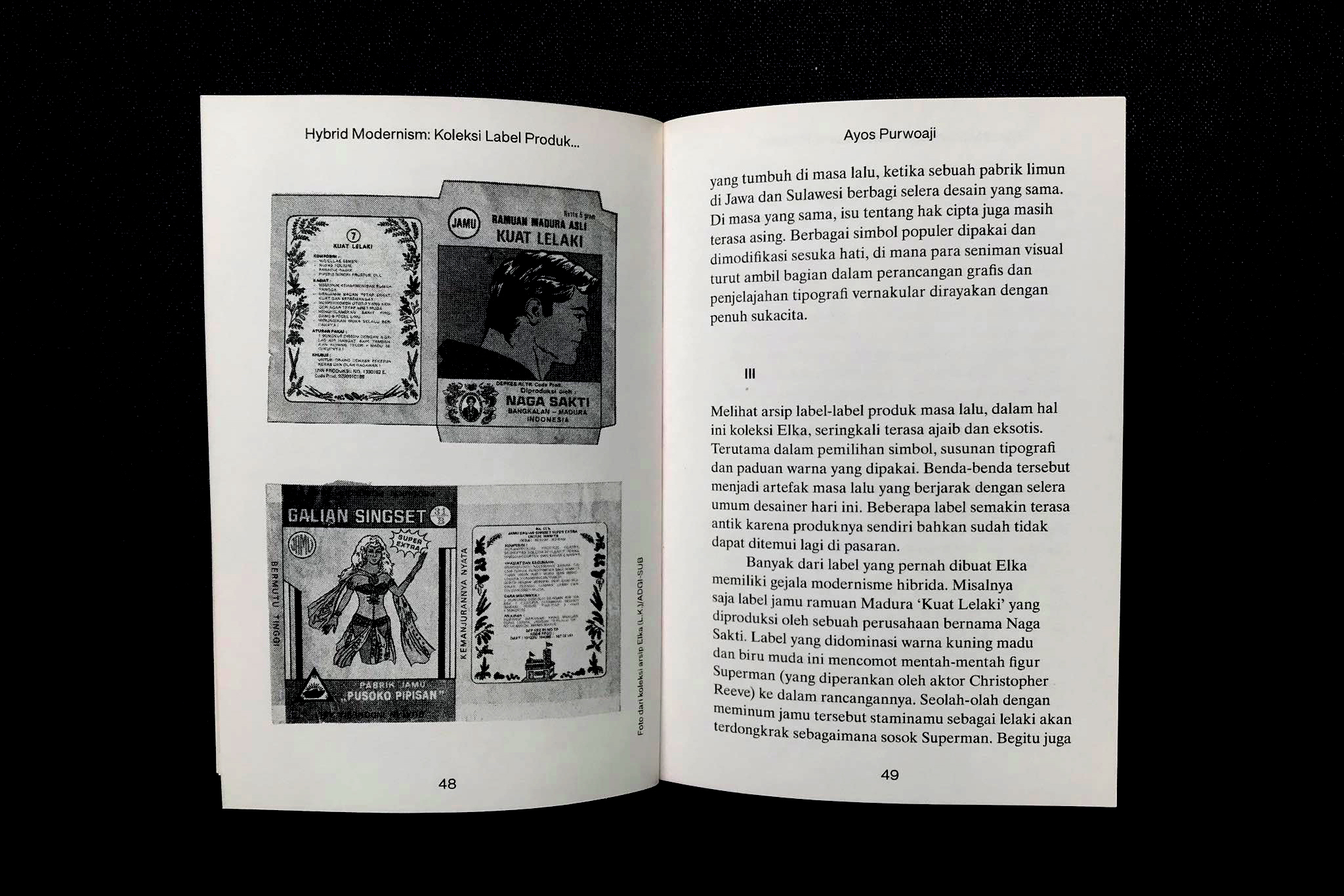
Pic. 6 — Hybrid Modernism: Koleksi Label Produk dari Tahun 1950-an sampai dengan 1970-an written in Indonesian, spread from the article in Further Reading Print No.1.
Januar — It was mainly an article that talks about modernity, especially in graphic design.
The author of the article is a curator and a writer. He works a lot in art and cultural projects, so in this article he investigates graphic design modernism through packaging. The discussion is that modernity has never completely evolved, or has never completely fit in into our culture. He called it fifty percent modernity, so it has never fully completed. The reason it has never fully developed in our country is because we have such a diverse culture. In the packaging images you will see like Indonesia language, Chinese scripts, and also some English words. He specifically talked about the images, about these superhero images, how companies in Indonesia use superhero images to sell local contents. So it was mostly like a cross reference. In short, I think it is a proof that modernism has never fully embedded into our society because of our own locality, as it does happen in many southeast asian countries
นภิษา — คุณหมายถึงบทความชิ้นนี้ Hybrid Modernism: Koleksi Label Produk dari Tahun 1950-an sampai dengan 1970-an ที่เขียนเป็นภาษาอินโดใน Further Reading Print No.1 ใช่มั้ย? เราคิดว่าภาพของแพคเกจเหล่านี้น่าสนใจ คุณช่วยเหล่าให้ฟังหน่อยว่าบทความนี้เกี่ยวกับอะไร?
รูป 6 — หน้าตัวอย่างจากบทความ Hybrid Modernism: Koleksi Label Produk dari Tahun 1950-an sampai dengan 1970-an ที่ตีพิมพ์ใน Further Reading Print No.1
จานัวร์ — บทความนี้พูดถึงความเป็นสมัยใหม่ (modernity) โดยเฉพาะในกราฟิกดีไซน์ ผู้เขียนเป็นคิวเรเตอร์และนักเขียน เขาทำโปรเจกต์หลายอย่างเกี่ยวกับศิลปะและวัฒนธรรม สำหรับในบทความนี้เขาสำรวจความเป็นสมัยใหม่ในกราฟิกดีไซน์ผ่านบรรจุภัณฑ์ ข้อถกเถียงคือ ความเป็นสมัยใหม่นี้ไม่เคยได้มีวิวัฒนาการอย่างเต็มที่ หรือไม่เคยเข้ากันได้กับวัฒนธรรมของพวกเรา ผู้เขียนเรียกมันว่าเป็นเพียงห้าสิบเปอร์เซนต์ของความเป็นสมัยใหม่ ซึ่งหมายความว่ามันไม่ได้เกิดขึ้นอย่างเต็มที่ สาเหตุที่มันไม่เคยพัฒนาอย่างเต็มที่ในประเทศของเราก็เพราะวัฒนธรรมอันหลากหลายของอินโดนีเซีย ในรูปบรรจุภัณฑ์จะเห็นภาษาอินโด ตัวอักษรจีน และคำภาษาอังกฤษ เขายังพูดถึงรูปภาพ โดยเฉพาะรูปภาพซูเปอร์ฮีโร่และวิธีการที่บริษัทในอินโดนีเซียใช้ภาพซูเปอร์ฮีโร่ในการขายเนื้อหาท้องถิ่น มันเหมือนกับแหล่งอ้างอิงที่โยงไปสู่อย่างอื่น เรารู้สึกว่ามันเป็นหลักฐานที่แสดงให้เห็นว่าความเป็นสมัยใหม่ไม่เคยฝังตัวอยู่ในสังคมเราจริงๆ เพราะความเฉพาะตัวของท้องถิ่นเอง ซึ่งสิ่งนี้ก็เกิดขึ้นกับหลายๆ ประเทศในเอเชียตะวันออกเฉียงใต้
Napisa — It reminds me of the book by a Thai designer/writer, Pracha Suveeranont, Thai Thai, it was published almost ten years ago. He writes about the visual language in design works and advertisements that have ‘Thai Thai’ condition. ‘Thai Thai’ is Thai street culture or vernacular culture. Using ‘Thai Thai’ by doubling the previous word, in Thai language is to dilute the meaning of the word itself. For example, when you say ‘Dang dang’ (dang means red in Thai), it means something that is not really red. This Thai street culture became widely researched and gained more popularity among the designers than traditional Thai style during that period of time. He analysed this phenomenon through various kinds of design medium whether movie poster, advertisement, and packaging. The book also contains an article referring to The Others Within by Thongchai Winichakul, a Thai academic. He writes about the way Siamese elites in the time of colonization look at Thai villagers as ‘the other’ imitating the way the westerner looks at Their colonized people.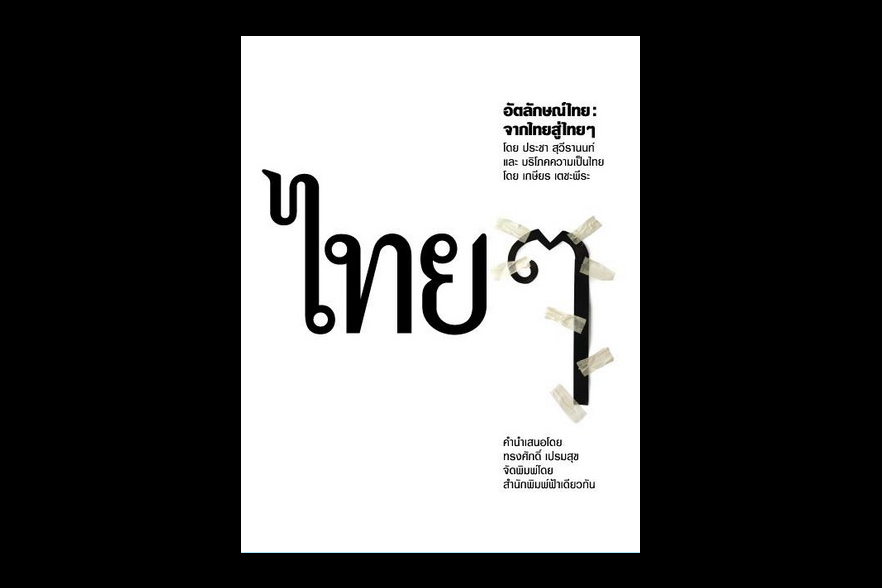
Pic. 7 — ไทยๆ (Thai Thai) by Pracha Suveeranont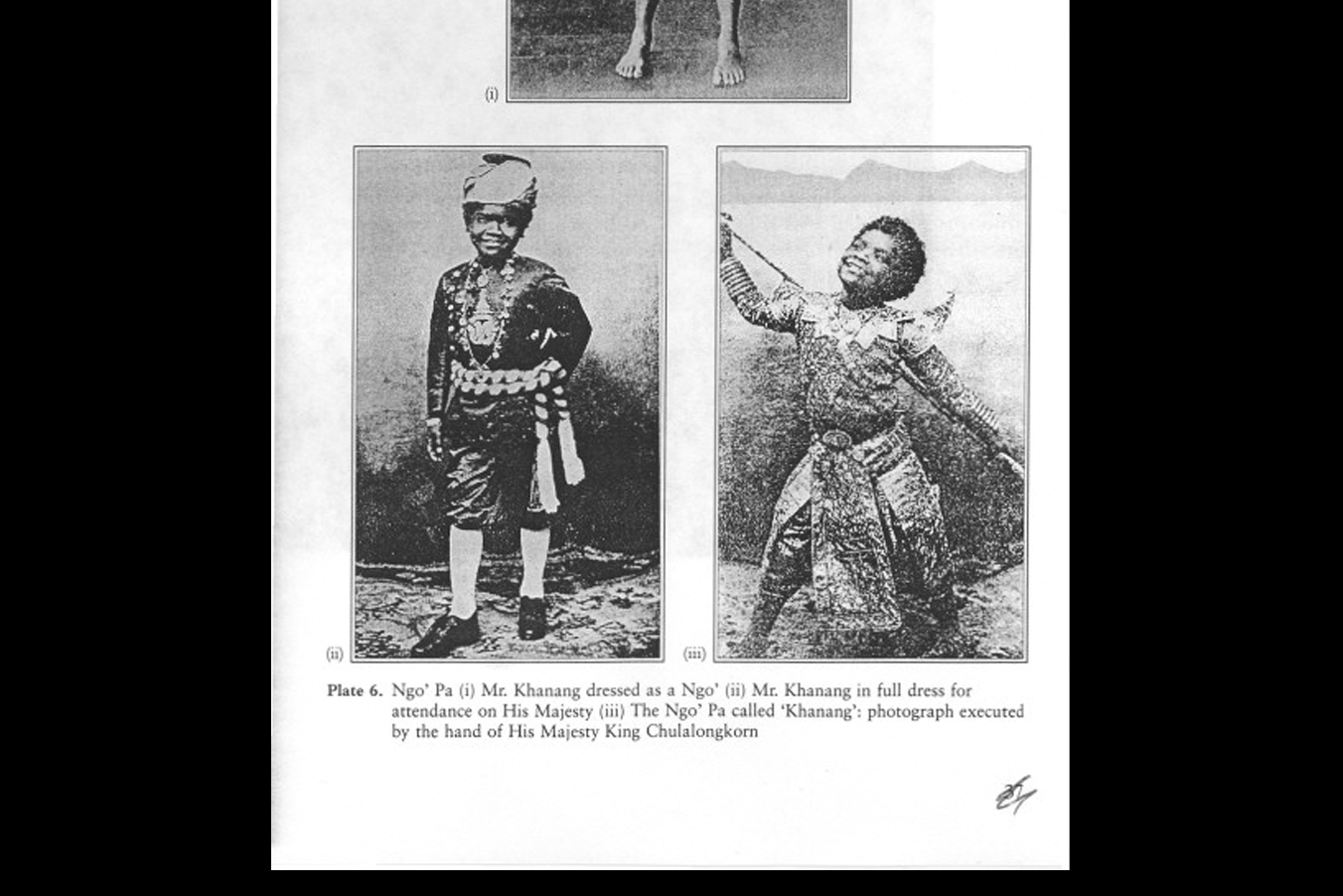
Pic. 8 — Images inserted in the article The Others Within by Thongchai Winichakul, the photographs of Mr.Khanang dressed as a ‘Ngo’, a character in Thai literature Ngo Pa written by His Majesty King Chulalongkorn (King Rama V).
Talking about this book, it’s a long time ago I couldn’t find a book that really deals with design culture by Thai author. This country is also lacking this kind of content.
You said in the beginning that you want to interact with other disciplines. Why do you want to do that? It is my observation that a lot of graphic designers are interested in this kind of initiating project that goes beyond the traditional graphic medium, like doing an exhibition. Why do you think a lot of graphic designers are interested in this kind of work?
Januar — Because graphic design is such a facilitating discipline, so we basically, in a way, a communicator for other disciplines. Back in the day, I worked in a design studio that works quite a lot on art. We basically did exhibition identity or art catalogue for them. Graphic design is mainly facilitating art to communicate to the public, so I think because of this means of the discipline that makes most graphic designers interested in exploring the potential of working with other disciplines because graphic design is never really working on itself.
In a broader sense, graphic design has always existed around other disciplines. Even doing a publication, we are working with a printer, a bookshop, a contributor etc., and contributors are also from different backgrounds, different disciplines, like art, architecture. So I think that is a reason it is, in a way, so flexible.
นภิษา — มันทำให้ฉันนึกถึงหนังสือชื่อ ไทยๆ โดยนักออกแบบและนักเขียนชาวไทย ชื่อประชา สุวีรานนท์ ตีพิมพ์เมื่อเกือบสิบปีก่อน เขาเขียนถึงภาษาภาพในงานออกแบบและโฆษณาที่มีความเป็น ‘ไทยๆ’ คือความเป็นไทยแบบชาวบ้าน ที่เห็นได้ตามท้องถนน การใช้คำว่า ‘ไทยๆ’ โดยเติม ‘ๆ’ ประชาให้เหตุผลว่าเป็นการทำให้ความเป็นไทยเจือจางลง คล้ายๆ กับการพูดว่าอะไรสีแดงๆ ก็คือไม่ใช่สีแดงซะทีเดียว ‘ไทยๆ’ เป็นปรากฎการณ์ที่ก้าวมาเป็นองค์ความรู้ที่ดูเหมือนจะโดดเด่นเป็นไทยมากกว่าไทยประเพณี เขาเขียนถึงมันผ่านการวิเคราะห์งานสร้างสรรค์หลายแขนง เช่น โปสเตอร์ภาพยนตร์ โฆษณา บรรจุภัณฑ์ ในเล่มยังมีข้อเขียนที่ดึงมาจากบทความ The Others Within โดยธงชัย วินิจจะกูล นักวิชาการไทยที่เขียนถึงการมองชาวบ้านเป็น ‘คนอื่น’ ของชนชั้นนำสยามในยุคล่าอาณานิยม ที่หยิบยืมแนวคิดต่างชาติมาใช้มองคนไทยด้วยกันเองด้วย
รูป 7 — ไทยๆ โดยประชา สุวีรานนท์
รูป 8 — ภาพในบทความชื่อ The Others Within โดย ธงชัย วินิจจะกูล เป็นภาพถ่ายของคนัง ที่แต่งตัวเป็น ‘เงาะ’ ตัวละครในนวนิยายเรื่อง เงาะป่า พระราชนิพนธ์ในพระบาทสมเด็จพระจุลจอมเกล้าเจ้าอยู่หัว รัชกาลที่ 5
พูดถึงแล้วก็ทำให้คิดว่านานมาแล้วที่เราไม่ได้อ่านบทความเกี่ยวกับการวัฒนธรรมการออกแบบจากนักเขียนไทย ประเทศเราก็ขาดสิ่งเหล่านี้เหมือนกัน
คุณบอกว่าในตอนเริ่มว่าคุณอยากที่จะมีปฏิสัมพันธ์กับสาขาวิชาอื่น ทำไมถึงเป็นแบบนั้น ฉันสังเกตว่ามีนักออกแบบหลายคนที่สนใจคิดค้นโปรเจกต์ของตัวเองที่ออกไปจากกรอบของการทำกราฟิกโดยปกติ อย่างเช่นการทำนิทรรศการ คุณคิดว่าเป็นเพราะอะไร นักออกแบบถึงสนใจทำงานเหล่านี้?
จานัวร์ — เพราะกราฟิกดีไซน์เป็นสาขาวิชาที่ทำหน้าที่ส่งเสริมสิ่งอื่น นั่นทำให้เราเป็นผู้ที่สื่อสารให้กับสาขาวิชาอื่นๆ ย้อนกลับไปเมื่อเรายังทำงานในสตูดิโอออกแบบซึ่งทำงานส่วนใหญ่เกี่ยวกับศิลปะ เราทำอัตลักษณ์ของนิทรรศการและแคตตาล็อกศิลปะสำหรับนิทรรศการ กราฟิกดีไซน์เป็นศิลปะของการสนับสนุนเพื่อสื่อสารกับสาธารณะ เราคิดว่าเป็นเพราะจุดหมายของสาขาวิชานี้ที่ทำให้กราฟิกดีไซเนอร์จำนวนมากสนใจในการสำรวจการทำงานกับสาขาวิชาอื่นๆ เพราะจริงๆ แล้วกราฟิกดีไซน์ไม่ได้ทำงานเกี่ยวกับตัวมันเอง
ในมุมมองที่กว้างกว่านั้น กราฟิกดีไซน์มีตัวตนอยู่รอบสาขาวิชาอื่นๆ อย่างการทำสิ่งพิมพ์ขึ้นมา เราต้องทำงานกับโรงพิมพ์ ร้านหนังสือ นักเขียนที่มาร่วมงาน ฯลฯ และผู้ที่มาร่วมงานเหล่านั้นก็มีภูมิหลังที่ต่างกัน อยู่ในสาขาวิชาที่ต่างกัน เช่น ศิลปะหรือสถาปัตยกรรม ซึ่งนั่นเป็นสาเหตุที่เราคิดว่าทำให้กราฟิกดีไซน์มีความยืดหยุ่นสูง
Napisa — I think the flexibility of graphic design makes it more invisible, because we work with a content that does not come from ourselves.
To do something else besides the practice of graphic design discipline, like doing an exhibition, can help make the content that is chosen by ourselves and we are interested in become visible.
Moreover, by doing a self-initiated exhibition we open an opportunity to work with a group of people who don’t come from the commercial sector. And this can bring more possibility of experimentation on the discipline.
Waterproof Exhibitions begins by the idea of creating a space for topics that we are interested in. For our first exhibition, Bibliomania, we want to present the possibility of artists’ books. My own interest is about book space as exhibition space, books as an art object, and the way we can see it as something else in order to experiment with its form by new methods.
Although the interest is in unconventional experimentations of a book form, like the sausage book of Dieter Roth, as a graphic designer when I have to do my own work or even a client work about book I am more inclined to the idea of book in its simplicity and looks for the possibility under the limitation of the typical printer. I got The Form of the Book Book published by Occasional Papers from Antwerp Art Book Fair. There is one chapter of the book that mentions the superfluous designs on many art-related books. I am interested in finding the balance of placing artworks or artwork’s images on the space of a book either in terms of form, layout and typography.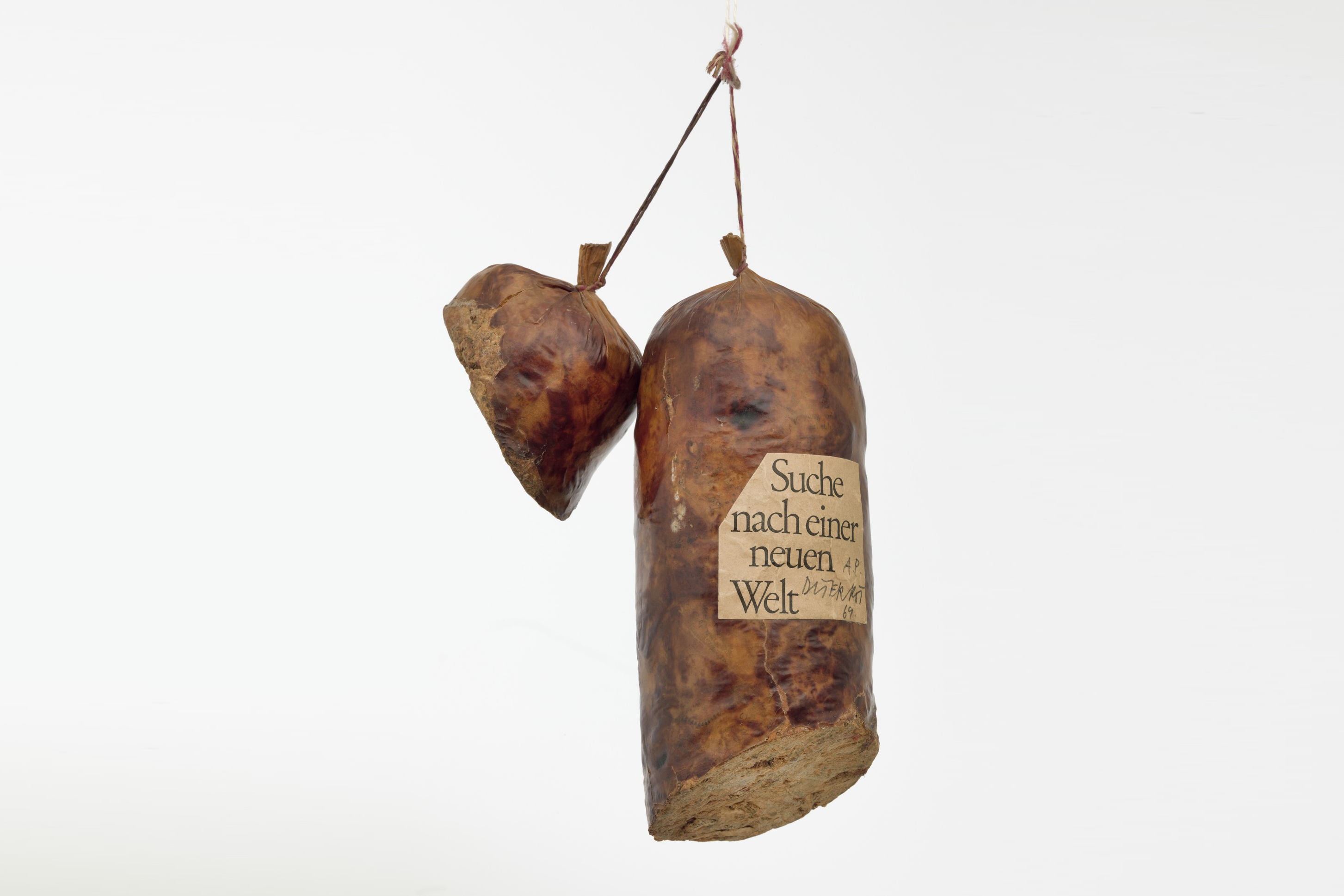
Pic. 9 — Literature Sausage (Literaturwurst) by Dieter Roth,
1969.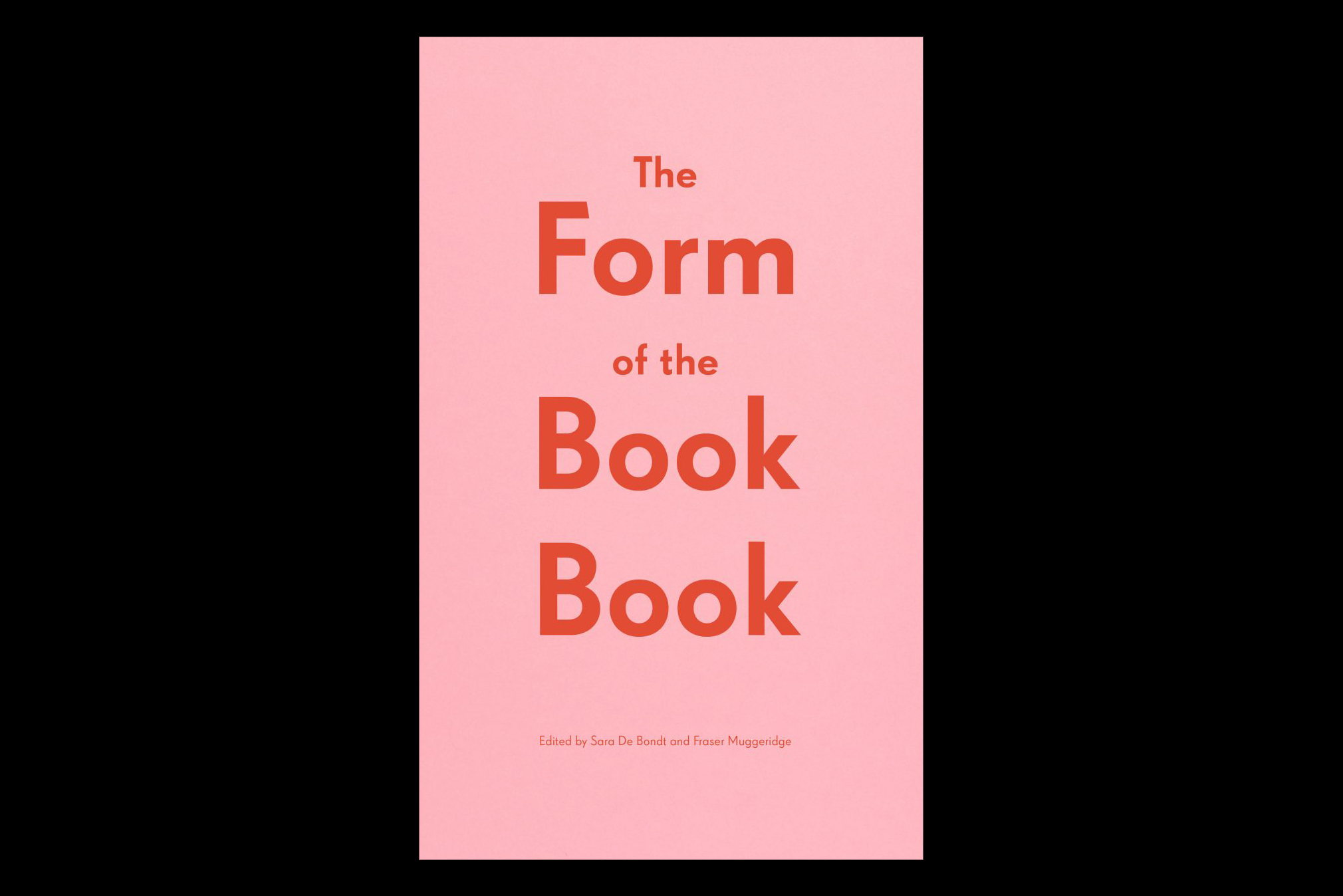
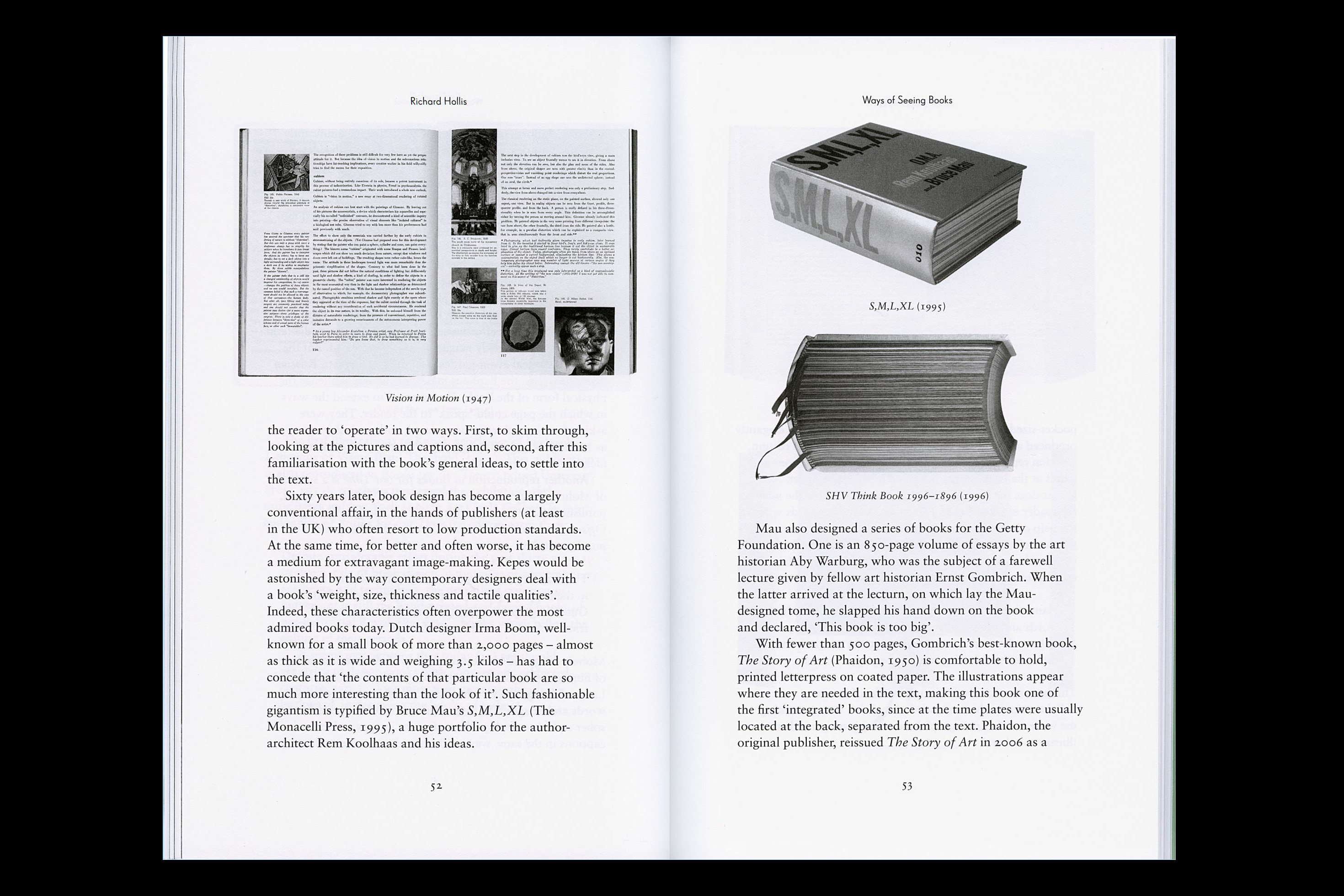
Pic. 10-11 — The Form of Book Book edited by Sara De Bondt and Fraser Muggeridge, published by Occasional Papers.
Do you see any urgent or crucial needs in the field of graphic design and publishing in Indonesia, or even in the broader context? What are you working on right now? And what are you reading right now?
Januar — The urgency in Indonesia, for me, is mainly to provide the alternative reading references. What we have in design schools right now compared to twenty years ago is still the same, it was mainly graphic design as a commodity, in a commercial aspect. I think it is important to provide some alternatives, so that it is not self-referential. We can still explore the potential of graphic design as a discipline, but it is not only for commercial work. We can also do cultural stuff and things beyond commercial. I’m not sure about urgency in other countries but maybe in Southeast Asia it is still the same.
In Asia, graphic design starts to gain some popularity compared to the west because design has originated from the west and they have been doing it like forever. So, I think particularly in Asia, we still have some rooms, some space to develop the way the discipline could be, or should go to.
For the recent project we are working on, one is the second printed publication which is due to be available in September. And also we have been working with an exhibition in Guangzhou, the exhibition is focused on graphic design from East Asia, and my work particularly is about common reading within Southeast Asia. What creatives are reading here? We are reading a lot from the west, or we are reading from our local culture. The project investigates the way we read, the way graphic design is read, and also the influences of that. It is an ongoing project and the exhibition is the starting point. Like I said there is a lot of room graphic design can be developed, particularly in Southeast Asia, so it is important to see what we read, what we consume basically, and then what we produce out of it.
I’m not reading much lately, mostly due to crippling tasks we have to do at the studio (works for our clients) as well as editing contents for the upcoming Further Reading Print No.2, which I consider an irony (not being able to read as much, as Further Reading progresses, compared to what we did in the beginning). But some of my recent reads include: Are We Human? Notes on an Archaeology of Design Paperback by Beatriz Colomina and Mark Wigley, and Design as an Attitude by Alice Rawsthorn.
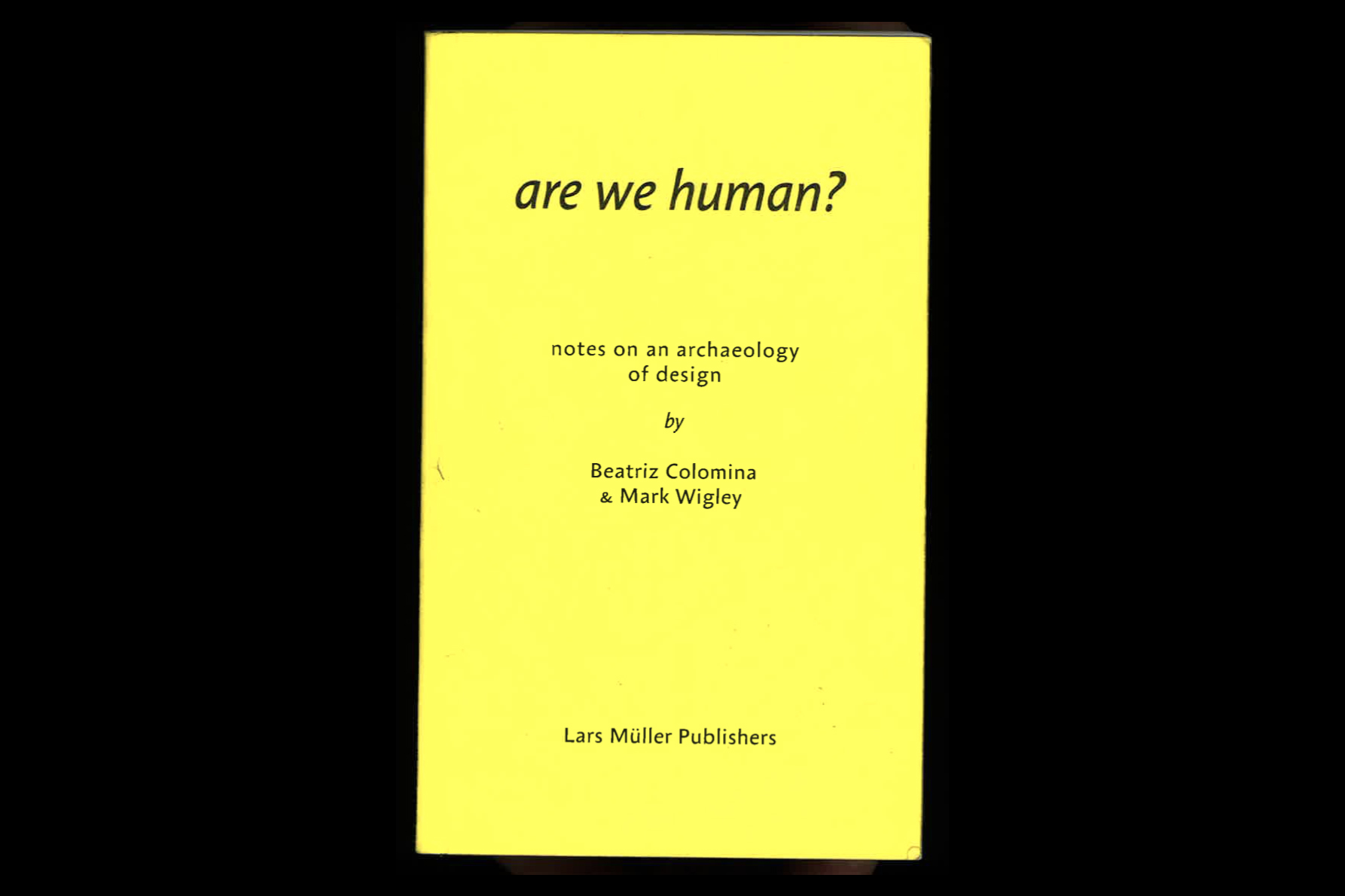
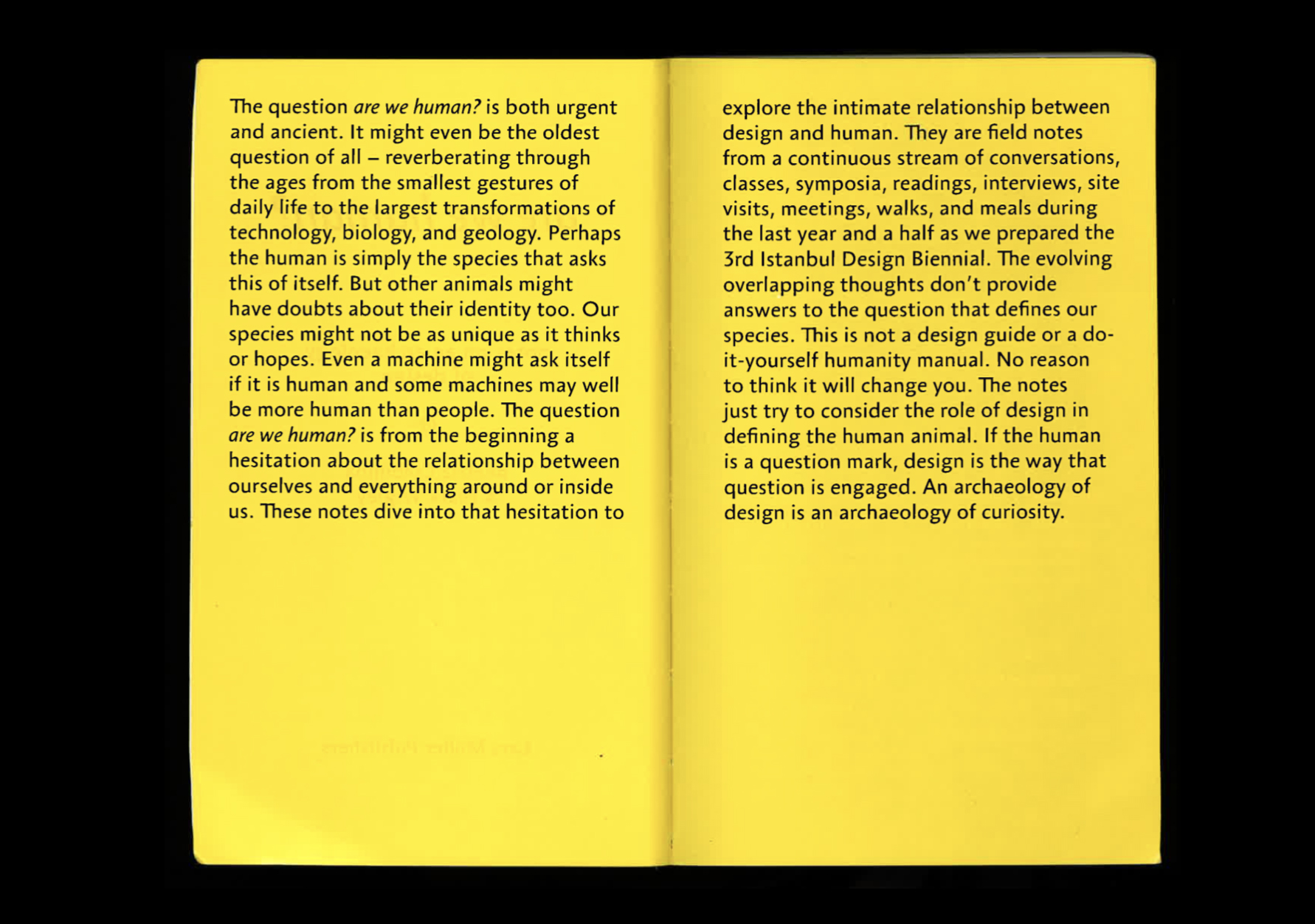
Pic. 12-13 — Are We Human? Notes on an Archaeology of Design Paperback by Beatriz Colomina and Mark Wigley.
Pic. 14 — Design as an Attitude by Alice Rawsthorn
นภิษา — โดยส่วนตัวแล้วฉันคิดว่าการที่มันยืดหยุ่น ทำให้การทำงานของกราฟิกดีไซน์เองไม่ถูกมองเห็นเท่าไหร่ เมื่อเราทำงานเพื่อส่งเสริมสิ่งอื่นที่ไม่ได้มีเนื้อหามาจากเราเอง
ฉันคิดว่าการพยายามที่จะทำอย่างอื่นนอกไปจากการทำงานในสาขาวิชา อย่างการทำนิทรรศการ ทำให้เราได้มีพื้นที่ในการค้นคว้าประเด็นที่เราสนใจจริงๆ เพื่อทำให้ถูกมองเห็นว่ากราฟิกดีไซเนอร์เองก็มีสิ่งที่สนใจและอยากพูดถึงด้วยเหมือนกัน
ในขณะเดียวกันการทำนิทรรศการก็เปิดโอกาสให้เราได้ทำงานกับกลุ่มคนที่เราสนใจในบริบทที่ไม่ใช่เชิงพาณิชย์ ซึ่งมันช่วยทำให้เราได้ทดลองทำสิ่งต่างๆ อย่างไร้ข้อจำกัด
Waterproof Exhibitions ก็เกิดขึ้นมาด้วยความคิดว่าเราอยากที่จะมีพื้นที่พูดเรื่องที่เราสนใจ อย่างในนิทรรศการแรกที่ชื่อ Bibliomania เราอยากนำเสนอความเป็นไปได้ของสิ่งพิมพ์ศิลปิน โดยส่วนตัวแล้วฉันสนใจการทำหนังสือโดยศิลปิน วิธีคิดเกี่ยวกับพื้นที่ของหนังสือในฐานะเป็นพื้นที่แสดงนิทรรศการ หนังสือในฐานะวัตถุทางศิลปะ การมองมันเป็นสิ่งอื่นเพื่อที่จะเข้าไปทดลองกับรูปแบบของมันด้วยวิธีการใหม่ๆ
ถึงแม้ว่าจะสนใจการตีความใหม่ๆ และการทดลองที่นอกกรอบของศิลปิน อย่างงานหนังสือไส้กรอกของดีเธอ โรท (Dieter Roth) ในฐานะกราฟิกดีไซเนอร์เอง เมื่อจะต้องผลิตผลงานของตัวเอง หรือทำงานให้กับศิลปิน ฉันกลับสนใจรูปแบบที่เรียบง่ายของหนังสือ และการหาความเป็นไปได้ที่น่าสนใจภายใต้ข้อจำกัดของโรงพิมพ์ ฉันได้หนังสือชื่อ The Form of the Book Book ตีพิมพ์โดยสำนักพิมพ์ Occasioanl Papers มาจาก Antwerp Art Book Fair มีตอนหนึ่งพูดถึงประเด็นว่าหนังสือเกี่ยวกับศิลปะหลายเล่ม ถูกตีความผ่านการออกแบบเกินผลงานของศิลปิน โดยส่วนตัวแล้วฉันสนใจการหาสมดุลในการจัดการกับงานศิลปะของศิลปินบนพื้นที่ของหนังสือ ทั้งในแง่ของรูปแบบ และการจัดวางภาพและตัวอักษร
รูป 9 — Literature Sausage (Literaturwurst) โดย ดีเธอ โรท, 2512

รูป 10-11 — The Form of Book Book เรียบเรียงโดย ซาร่า เดอ บนด์ และ เฟรเซอร์ มักเกอริจด์ ตีพิมพ์โดย Occasional Papers.
คุณเห็นว่ามีเรื่องเร่งด่วนหรือเรื่องจำเป็นในแง่ของกราฟิกดีไซน์และการตีพิมพ์ในอินโดนีเซีย หรือในมุมที่กว้างกว่านั้นบ้างมั้ย? โปรเจกต์ที่คุณกำลังทำอยู่ตอนนี้มีอะไรบ้าง และตอนนี้คุณกำลังอ่านอะไรอยู่?
จานัวร์ — เรื่องเร่งด่วนในอินโดนีเซียสำหรับเราคือการมีทางเลือกในแหล่งการอ่านอื่นๆ สิ่งที่เรามีอยู่ในโรงเรียนดีไซน์ตอนนี้ไม่ต่างจากสิ่งที่เคยมีเมื่อยี่สิบปีที่ผ่านมา นั่นคือกราฟิกดีไซน์ในฐานะสินค้า ในมุมมองเชิงพาณิชย์ เราคิดว่ามันสำคัญที่เราต้องมีทางเลือกอื่นๆ เพื่อไม่ให้เราเอาแต่อ้างอิงตัวเอง เราสามารถสำรวจความเป็นไปได้ของกราฟิกดีไซน์ในฐานะสาขาวิชา ที่ไม่ได้ทำแค่เพียงงานเชิงพาณิชย์ เราสามารถทำงานในเชิงวัฒนธรรมได้ด้วย เราไม่แน่ใจกับเรื่องเร่งด่วนในประเทศอื่นๆ แต่สำหรับประเทศอื่นในเอเชียตะวันออกเฉียงใต้ก็อาจกำลังเจอปัญหาแบบเดียวกัน ในเอเชีย กราฟิกดีไซน์เริ่มได้รับความสนใจเมื่อเทียบกับตะวันตก เพราะในตะวันตกซึ่งเป็นที่ที่กราฟิกดีไซน์เกิดขึ้นนั้น พวกเขาทำมันมานานมากแล้ว และเราคิดว่าโดยเฉพาะในเอเชียเรายังมีพื้นที่ที่สามารถพัฒนาสิ่งที่สาขาวิชานี้สามารถเป็นได้ หรือแนวทางที่มันควรจะดำเนินไปอยู่
สำหรับโปรเจกต์ล่าสุดที่เรากำลังทำอยู่นั้น หนึ่งในนั้นคือสิ่งพิมพ์เล่มสองที่กำลังจะเผยแพร่ในเดือนกันยายน และพวกเรากำลังทำงานร่วมกับนิทรรศการในกวางโจว ซึ่งมุ่งความสนใจไปที่กราฟิกดีไซน์ในเอเชียตะวันออก และงานของเราในนิทรรศการนั้นเกี่ยวกับการอ่านโดยทั่วไปในเอเชียตะวันออกเฉียงใต้ สิ่งที่นักสร้างสรรค์จากเอเชียตะวันออกเฉียใต้อ่านคืออะไร พวกเราอ่านสิ่งที่มาจากตะวันตกหรือจากวัฒนธรรมของเราเองเป็นส่วนใหญ่ โปรเจกต์นี้สำรวจวิธีการอ่านของพวกเรา เรื่องว่ากราฟิกดีไซน์ถูกอ่านอย่างไร และอิทธิพลที่ทำให้เกิดวิธีการเหล่านั้น มันเป็นโปรเจกต์ที่อยู่ระหว่างการดำเนินการ และนิทรรศการนี้เป็นจุดเริ่มต้น อย่างที่บอกว่ากราฟิกดีไซน์สามารถพัฒนาได้อีกมากในเอเชียตะวันออกเฉียงใต้ นั่นทำให้การศึกษาถึงสิ่งที่เราอ่าน สิ่งที่เราบริโภค และสิ่งที่เราผลิตออกมาจากสิ่งเหล่านั้น เป็นเรื่องที่สำคัญ
เราไม่ค่อยได้อ่านหนังสือมากนักช่วงนี้ เป็นเพราะต้องใช้เวลาส่วนมากไปกับการสะสางงานต่างๆ ที่เรามีที่สตูดิโอ (โปรเจกต์ของลูกค้า) รวมไปถึงงานเรียบเรียงเนื้อหาของ Further Reading Print No.2 ที่กำลังจะออก ฟังดูย้อนแยงที่เราไม่สามารถอ่านได้มากเท่ากับที่ Further Reading มันเติบโตขึ้น เทียบกับตอนที่เราเริ่มทำมัน แต่ถ้าจะพูดถึงสิ่งที่เพิ่งอ่านไปก็มี Are We Human? Notes on an Archaeology of Design Paperback โดย เบทริซ โคลอมินา ร่วมกับ มาร์ค วิกลีย์ และ Design as an Attitude โดยอลิซ รอวสตอน

รูป 12-13 — Are We Human? Notes on an Archaeology of Design Paperback โดย เบทริซ โคลอมินา และ มาร์ค วิกลีย์
รูป 14 — Design as a Attitude โดย อลิซ รอวสตอน
Napisa — The visual of the advertisements here in Bangkok are very vibrant and competitive. The city landscape is mostly conquered by this type of graphic; a large billboard with half of it occupied by flawless beauty of celebrities selling the products they represent. Talking about graphic designers here people, in general, would have no idea of the one who works for cultural sectors more than advertising. That is why I am interested in what Further Reading does which is a great alternative to the graphic design scene in Southeast Asia. A good example of how we can think about it in a different way. How do you see Further Reading in the future?
Januar — I prefer to keep it small, because then we have better quality discussions and internal value. And for me, we can navigate quickly within a small team. But for the direction of Further Reading as a publishing platform we would like to work together with designers or architects in the future. Maybe come up with a publication about them, develop some projects together apart from making publications. I think it is also important to keep promoting reading. Reading as a habit, especially in the country. It is important for the designer to read, because more substantial ideas come from reading. What we are trying to do in the next step is to familiarize reading through various media. May be not only through online, instagram, printed publications, but also through some activities, exhibitions, and installations. Something that is more familiar to people. Because reading in itself here in our country is somehow perceived as an intellectual thing, so it is not very approachable.
Maybe in the future we will do some kind of a podcast or merchandise that is related to reading. It is just a way to make it more familiar, or to make it more relevant. I think the importance is the dissemination of the information rather than the format. If we think it irrelevant to publish a printed publication in the future, maybe we can just do like a podcast or exhibition. What we are trying to do through Further Reading is to make sure that the information is well distributed through various exploration of media rather than just fixed into one or two.
นภิษา — ภาพของงานโฆษณาในกรุงเทพฯ มันทั้งจัดจ้านและแย่งกันโดดเด่น ทิวทัศน์ของเมืองถูกเอาชนะด้วยกราฟิกประเภทที่อยู่บนบิลบอร์ดขนาดใหญ่ ที่เกินครึ่งเป็นภาพของคนมีชื่อเสียงที่สวยงามไร้ที่ติขายสินค้าที่พวกเขาเป็นตัวแทนจำหน่าย โดยทั่วไปแล้วถ้าพูดถึงกราฟิกดีไซเนอร์ที่นี่ คนทั่วไปจะเข้าใจว่าทำงานในสายโฆษณามากกว่าสายวัฒนธรรม นั่นเป็นเหตุผลที่ทำให้ฉันสนใจในสิ่งที่ Further Reading ทำมากๆ เพราะมันช่วยให้เห็นทางเลือกในวงการกราฟิกในเอเชียตะวันออกเฉียงใต้ว่าไปในทิศทางอื่นๆ ได้ด้วย เป็นตัวอย่างที่ดีที่ทำให้คนเห็นการทำงานกราฟิกที่ต่างออกไป คุณเห็น Further Reading เป็นยังไงในอนาคต?
จานัวร์ — เราอยากทำให้กลุ่มมันเล็ก เพราะมันทำให้พวกเราเกิดการถกเถียงที่มีคุณภาพและสร้างคุณค่าภายใน พวกเราสื่อสารกันได้รวดเร็วกว่าในทีมเล็ก แต่ในส่วนของทิศทาง Further Reading ในฐานะแพลตฟอร์มเผยแพร่เนื้อหา ในอนาคตพวกเราอยากทำงานกับดีไซเนอร์และสถาปนิก อาจเป็นการทำสิ่งพิมพ์บางอย่างเกี่ยวกับพวกเขา หรือพัฒนาโปรเจกต์ร่วมกันนอกเหนือไปจากสิ่งพิมพ์ เราคิดว่าเรื่องการสนับสนุนการอ่านก็เป็นสิ่งสำคัญเช่นเดียวกัน ทำให้การอ่านเป็นนิสัยโดยเฉพาะในประเทศนี้ การอ่านเป็นสิ่งสำคัญสำหรับดีไซเนอร์ เพราะแนวคิดที่แข็งแรงมักเกิดขึ้นจากการอ่าน สิ่งที่พวกเราจะทำต่อไปคือการทำให้คนคุ้นเคยกับการอ่านผ่านมีเดียที่หลากหลาย อาจไม่ใช่แค่ผ่านแพลตฟอร์มออนไลน์ อินสตาแกรม สิ่งพิมพ์ แต่รวมถึงกิจกรรม นิทรรศการ อินสตอลเลชั่น หรือสิ่งที่ผู้คนคุ้นเคย เพราะการอ่านในประเทศเราถูกทำให้รู้สึกว่าเป็นเรื่องของคนมีสติปัญญา ทำให้รู้สึกว่ามันเข้าถึงยาก
ในอนาคตพวกเราอาจทำพอดแคสต์ หรือ สินค้าที่เกี่ยวข้องกับการอ่าน วิธีการที่ทำให้คนคุ้นเคยหรือรู้สึกว่าการอ่านมีความสำคัญมากขึ้น เราคิดว่าสิ่งสำคัญคือการทำให้ข้อมูลกระจายออกไปมากกว่าตัวรูปแบบของสื่อ ถ้าเราเห็นว่าการทำสิ่งพิมพ์ไม่ได้มีความสำคัญเราอาจเปลี่ยนมาทำพอดแคสต์ หรือนิทรรศการ สิ่งที่พวกเราต้องการจากการทำ Further Reading คือการทำให้ข้อมูลถูกเพยแพร่ออกไปอย่างมีประสิทธิภาพ ผ่านการทดลองในมีเดียต่างๆ มากกว่าการยึดติดอยู่กับสื่อเพียงไม่กี่อย่าง
Free pdf. download, available in Thai and English at DEAR READER, PLEASE READ: SHALL WE READ FURTHER?
ดาวน์โหลดฟรีในรูปแบบ pdf. ทั้งภาษาไทยและอังกฤษได้ที่ DEAR READER, PLEASE READ: SHALL WE READ FURTHER?
Further Reading (FR) is an independent multi-format publishing platform that compiles reading references, produces design periodicals, curates exhibitions and organises workshops. We seek to engage in discourse within design practices by exploring through the wider contexts.
Januar Rianto works at the intersection between design, education and popular culture as a designer, researcher, editor and curator. Graduated from London, he later broadened his research and design methodologies in Treviso and Tokyo focusing on speculative design and design critique. His practice mainly navigated through the peripheries of design, with intention to develop criticality towards design as a discipline and towards the subject it explores, by embodying design as a way of seeing and framework.
—
Waterproof Exhibitions is a portable art initiative found by Napisa Leelasuphapong and Rawiruj Suradin. Waterproof Exhibitions has a nomadic spirit. It neither bound to specific space nor certain time. It aims to be an experimental space for organising and showing art exhibitions and other artistic practices.
Rawiruj Suradin is a painter, interested in subject/object, foreground/background, 0/1. He co-founds Waterproof Exhibitions, a nomadic art initiative which aims to create a space for other ideas and entities
Napisa Leelasuphapong is a Thai graphic designer. She is interested in artists’ books and a concept of publishing as an artistic practice. She designs a publication seeing it as other things such as an object, an exhibition or a container to open for new possibilities of a publication format. She co-found Waterproof Exhibitions, for experimenting on art and organizing exhibitions, together with Rawiruj Suradin in 2018.
Further Reading (FR) เป็นแพลทฟอร์มเผยแพร่เนื้อหาแบบอิสระ ที่รวบรวมแหล่งอ้างอิงการอ่าน ผลิตบทความเกี่ยวกับการออกแบบ คิวเรทนิทรรศการ และจัดเวิร์กชอป เราสนใจการมีส่วนร่วมในวาทกรรมภายใต้การทำงานออกแบบ โดยค้นคว้าผ่านบริบทที่กว้างขึ้น
จานัวร์ ริยันโต ทำงานบนจุดตัดระหว่างการออกแบบ การศึกษา และวัฒนธรรมป๊อป ในฐานะนักการศึกษา นักวิจัย บรรณาธิการ และภัณฑารักษ์ หลังจบการศึกษาจากลอนดอน เขาขยายขอบเขตการวิจัยของตัวเอง และวิธีวิจัยของการออกแบบ ที่เมืองเทรวิโซ และโตเกียว โดยมุ่งความสนใจไปที่หัวข้อการคาดการณ์การออกแบบในอนาคต และการวิจารณ์การออกแบบ การทำงานของเขาหลักๆ นำทางด้วยสิ่งที่อยู่รอบๆ งานออกแบบ ด้วยความตั้งใจที่จะพัฒนาการวิจารณ์ระเบียบวิธีออกแบบ และการวิจารณ์หัวข้อที่ถูกศึกษา โดยการก่อรูปร่างการออกแบบในฐานะวิธีการมอง และขอบเขตการทำงาน
—
Waterproof Exhibitions เป็นกลุ่มริเริ่มทางศิลปะเคลื่อนที่ ก่อตั้งโดยนภิษา ลีละศุภพงษ์ และรวิรุจ สุรดินทร์ Waterproof Exhibitions มีจิตวิญญาณเร่ร่อน ไม่ยึดติดกับพื้นที่และเวลาเฉพาะ มันมีจุดมุ่งหมายที่จะเป็นพื้นที่ทดลองสำหรับการจัดนิทรรศการ จัดแสดงศิลปะ และวิธีการทางศิลปะอื่นๆ
รวิรุจ สุรดินทร์ เป็นจิตรกรที่มีความสนใจใน subject/object, พื้นหน้า/พื้นหลัง, 0/1 ร่วมก่อตั้ง Waterproof Exhibitions กลุ่มความเคลื่อนไหวทางศิลปะที่ตั้งใจสร้างพื้นที่สำหรับแนวคิดและสิ่งอื่นๆ
นภิษา ลีละศุภพงษ์ เป็นนักออกแบบกราฟิกสัญชาติไทย เธอสนใจในสิ่งพิมพ์ศิลปิน และแนวคิดของการตีพิมพ์ในฐานะการวิจัยทางศิลปะ เธอออกแบบสิ่งพิมพ์โดยมองมันเป็นสิ่งอื่น เช่นวัตถุ พื้นที่จัดแสดงนิทรรศการ หรือภาชนะ เพื่อเปิดทางให้กับความเป็นไปได้ใหม่ๆ ของรูปแบบของสิ่งพิมพ์ นภิษาก่อตั้ง Waterproof Exhibitions เพื่อทดลองทำงานศิลปะ และจัดนิทรรศการ ร่วมกับรวิรุจ สุรดินทร์ ในปี 2561
Cover image by Napisa Leelasuphapong.
ภาพปกโดย นภิษา ลีละศุภพงษ์
Proofread by Rawiruj Suradin, Supamas Phahulo, and Kantida Busaba
พิสูจน์อักษรโดย รวิรุจ สุรดินทร์, ศุภมาศ พะหุโล, กานต์ธิดา บุษบา
ถอดความเป็นภาษาไทยโดย รวิรุจ สุรดินทร์